Hanoi Train Street is one of those things you have to see to believe. Sure, trains pass through densely populated, highly urbanized areas every day all over the world, but few pass so close to the front doors of people’s homes as they do on this unmarked alleyway otherwise known as Train Street.
Train Street in Hanoi bucks the sanitized, regulated, and standardized world we increasingly find ourselves in, adding an element of intrigue, chaos, and, yes, just a bit of danger, to the everyday life of residents who call this unique alleyway home.
Naturally, we had to see it for ourselves. Train Street quickly found its way onto our shortlist of things to see and do in Hanoi, and having a toddler made seeing the Choo Choo street a priority.
But be forewarned, Hanoi Train Street is not for the faint of heart.
VISIT WITH EXTREME CAUTION
(particularly with little ones)
Guide to Visiting Hanoi Train Street [Responsibly]
Controversy & Deciding to Go
Having a daily locomotive barreling through your neighborhood mere centimeters from your front door may seem crazy, but the craziest thing about Train Street might just be the story of this unassuming thoroughfare of concrete block buildings meteoric rise to stardom in recent years.
When we last visited Hanoi in 2012, guidebooks and blogs at the time made little or no mention of a “Train Street,” and I can only assume that residents went about their daily lives as they had for many years without a constant stream of visitors.
It doesn’t take long to realize that a massive locomotive barreling through this neighborhood is regarded as unremarkable to these residents, who go about their daily business whether or not the 19:15 is rolling through.
Yet, somewhere along the way, that all changed. This neighborhood caught someone’s attention who broadcast their experience to other travelers. It could easily have been me or any other travel blogger writing about unknown and unique places. Or, it could have happened organically over time. After all, Train Street sits squarely at the crossroads of many of Hanoi’s top attractions. Regardless, it is now a fairly big attraction in its own right.
A couple of months before our recent visit to Hanoi, I came across a video highlighting Hanoi Train Street and the controversy around it, discussing the apparent tension between long-time locals and increasing tourist numbers.
When the neighborhood began seeing its first real surge of tourists, many in the community were none to happy about the influx. After all, this is their home, and they were witnessing it being transformed into a tourist attraction virtually overnight.

Though it seemed like the type of thing I’d love to see for myself, I also felt for the residents and decided it probably wasn’t something we should prioritize seeing.
A few weeks later, Lori caught wind of Train Street while researching things to do in Hanoi and really wanted to see it. I told her about the controversy, but she was undeterred.
Lori’s always been a bit more relaxed regarding doing or seeing controversial things on our travels. I, on the other hand, have a tendency to want to try to blend in and avoid rocking the boat in new places. Perhaps, it’s the Peace Corps volunteer in me.
But over the years I’ve also found that this mindset leads to seeing only what others in those places want you to see, which is often simply a facade. The most controversial, uncomfortable things often stand to teach us the most on our travels, and when we cut them out (like package tours so conveniently do) we get all the gravy and none of the meat.
On our first visit to Luang Prabang in 2012, I was convinced I didn’t want to have anything to do with Tak Bat (morning almsgiving), another controversial experience for visitors, as increasing tourist numbers (and inability for many to conduct themselves respectfully) have endangered the ancient daily ritual in the UNESCO town.
Lori made the argument that observers aren’t the problem, but disrespectful observers, and we could either skip the bucket list experience and miss out on something beautiful and unique to Laos, or we could go and observe in as unassuming and respectful a manner as possible.
Lori made a similar argument for seeing Hanoi Train Street, and in the end, I ceded my ground on the condition that we would do it in the most unassuming, respectful way as possible…at least as much as two people can with an infant and toddler along for the ride. Which, by the way, Lori, shouldn’t we be concerned about mixing small children and moving locomotives?
SPOILER ALERT: My fears about offending residents seemed to be largely unfounded, and all four of us do survive, at the cost of only a few limbs.
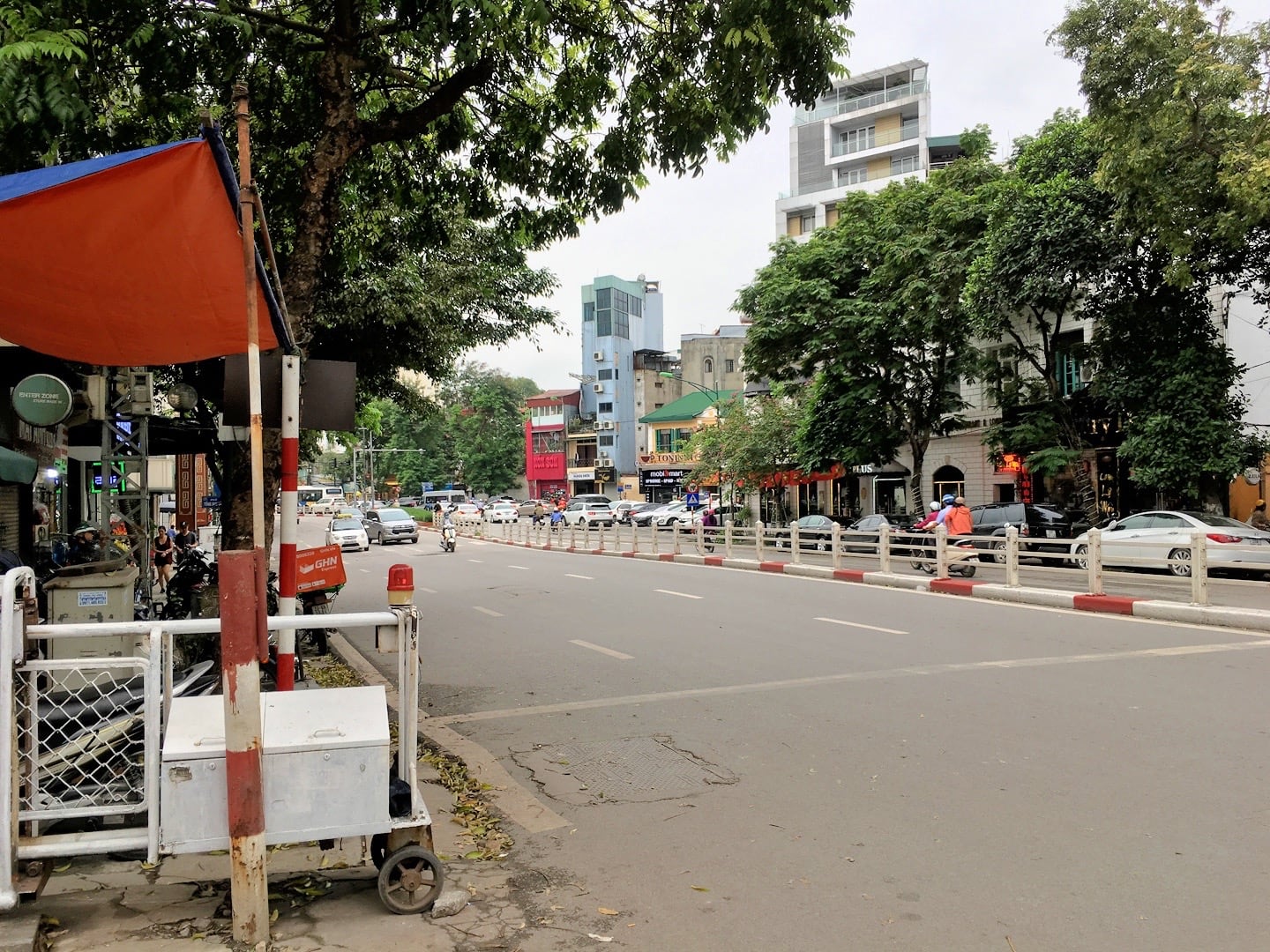
Our Hanoi Train Street Experience
Hanoi Train Street by Day
We were under the impression that the train comes through Train Street every day at around 3:15pm each day, but in fact, this is not the case (see our Hanoi Train Street Schedule section below for current times). As, such we made a point to be on the street no later than 3pm. It was a mad dash, but we arrived with time to spare, though at the time we had little idea of just how much time to spare.
Walking down the main avenue, we arrived at a railroad crossing, took a right, and found…
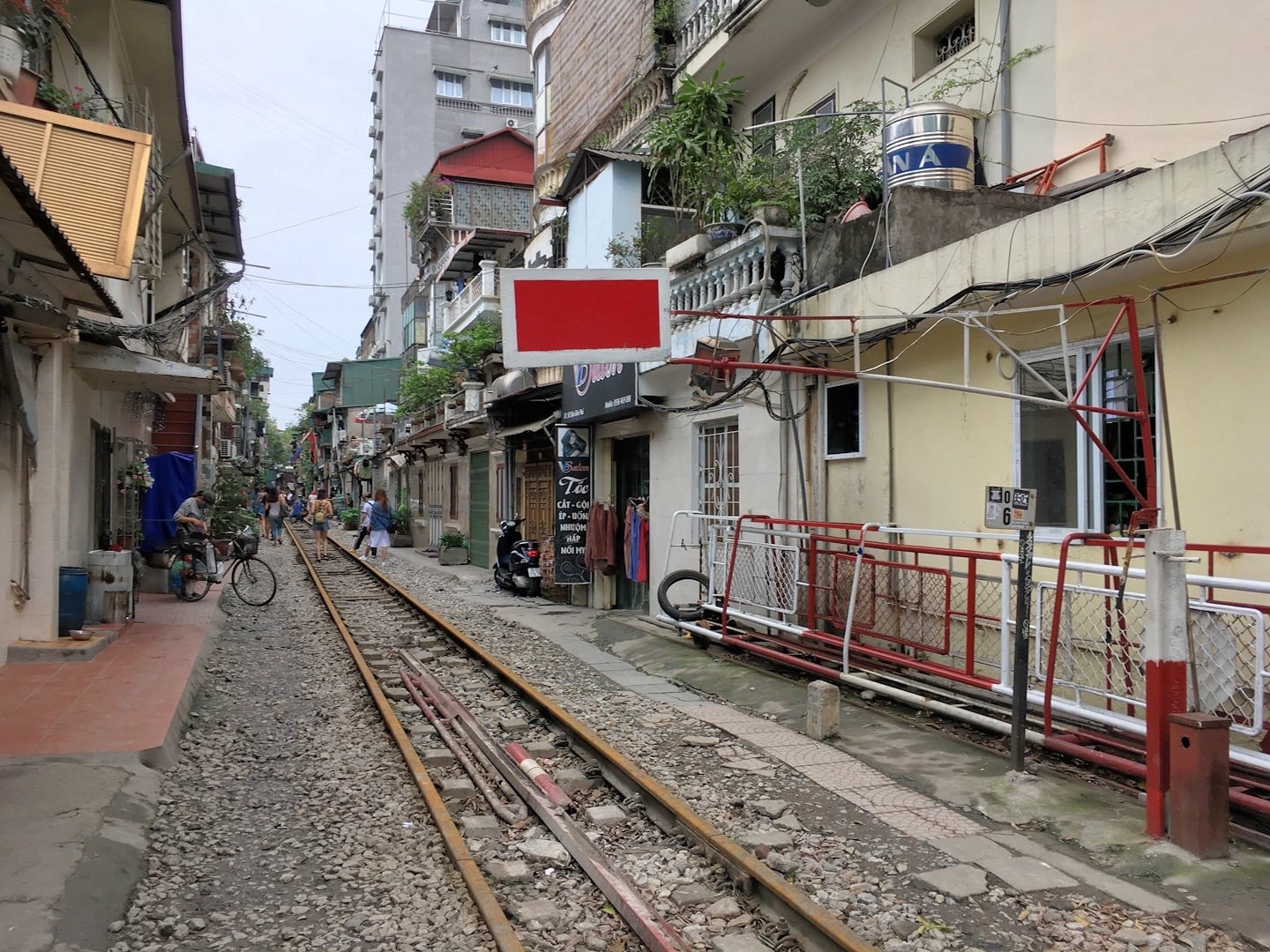
Train Street!
When we arrived, the neighborhood atmosphere felt strangely relaxed. We didn’t get the vibe that our presence was unwanted, nor did we get the sense that a large locomotive was passing through here any time soon. Like I said, pretty chill. Too chill… What’s up?
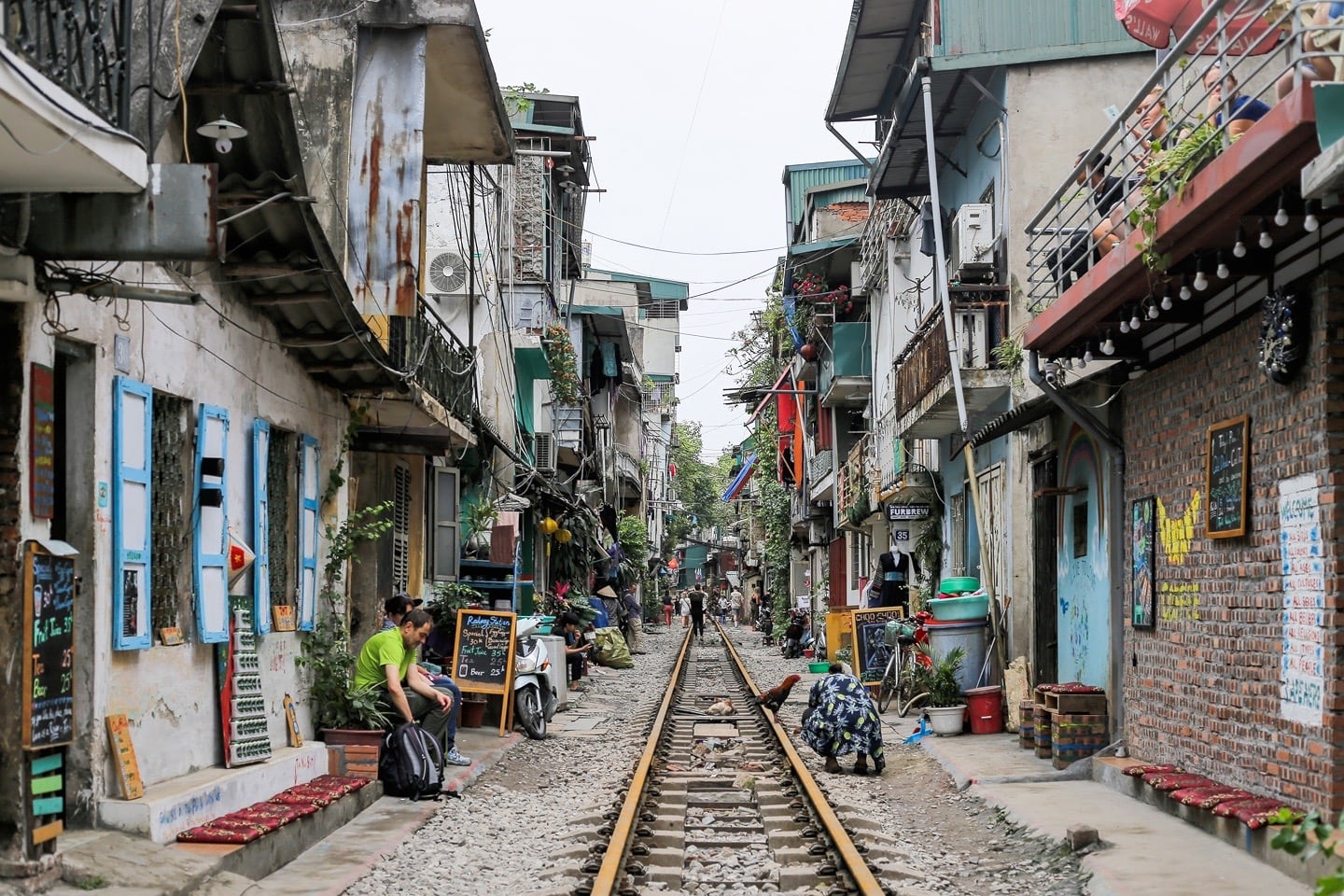
Then, we noticed a group of tourists perched on a balcony overlooking the tracks, which seemed to confirm our suspicions — this was in fact Train Street, and there was a train arriving soon.
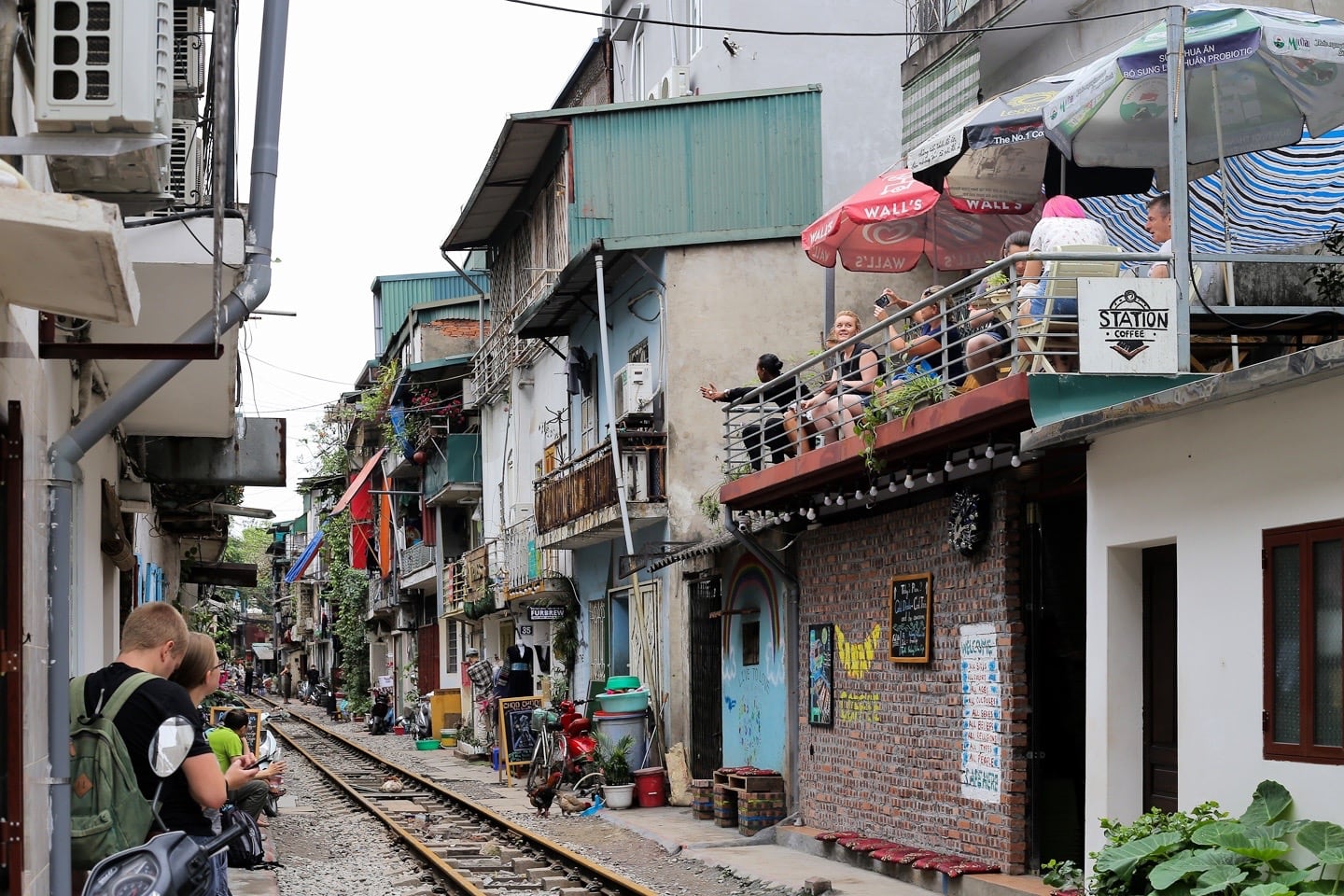
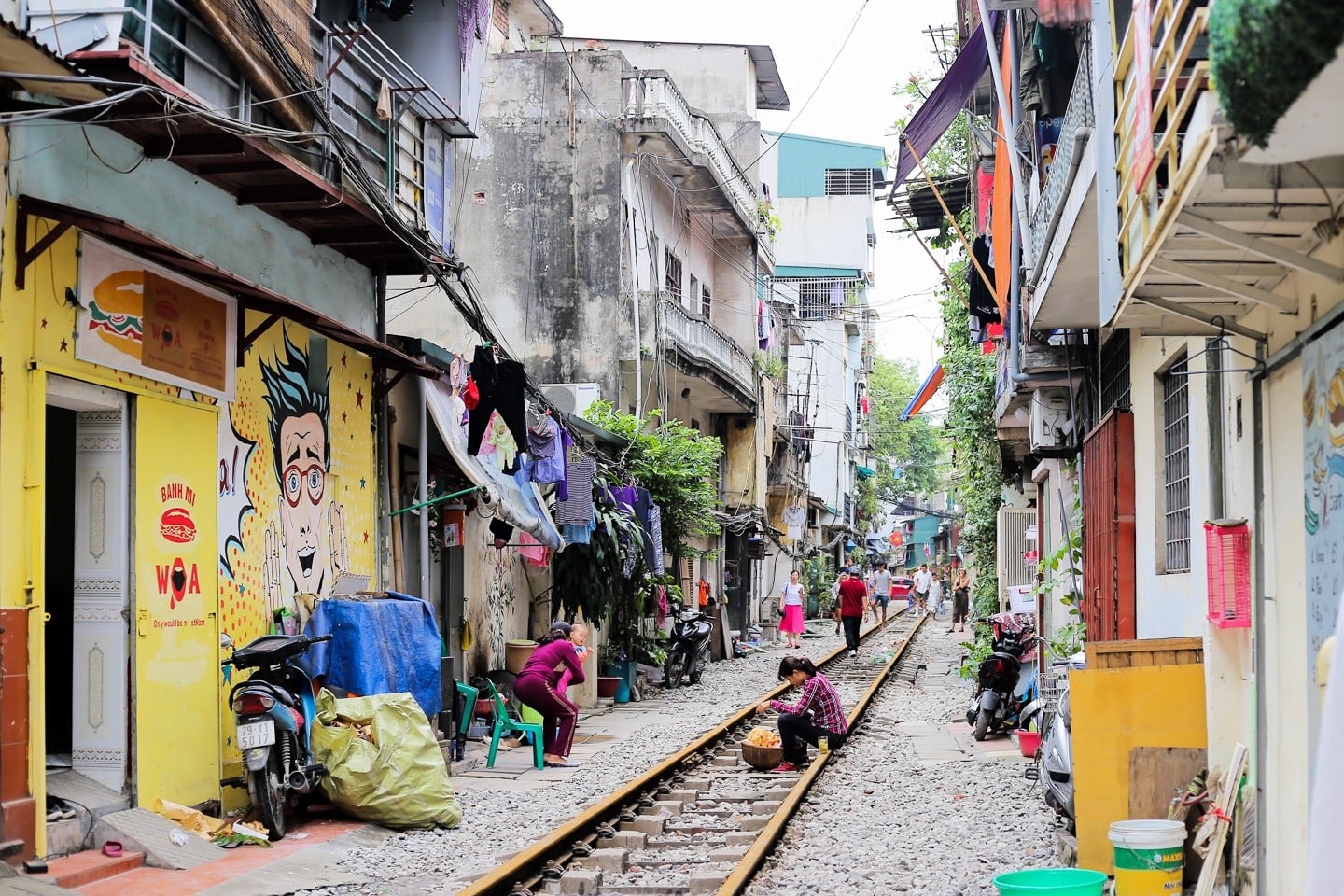
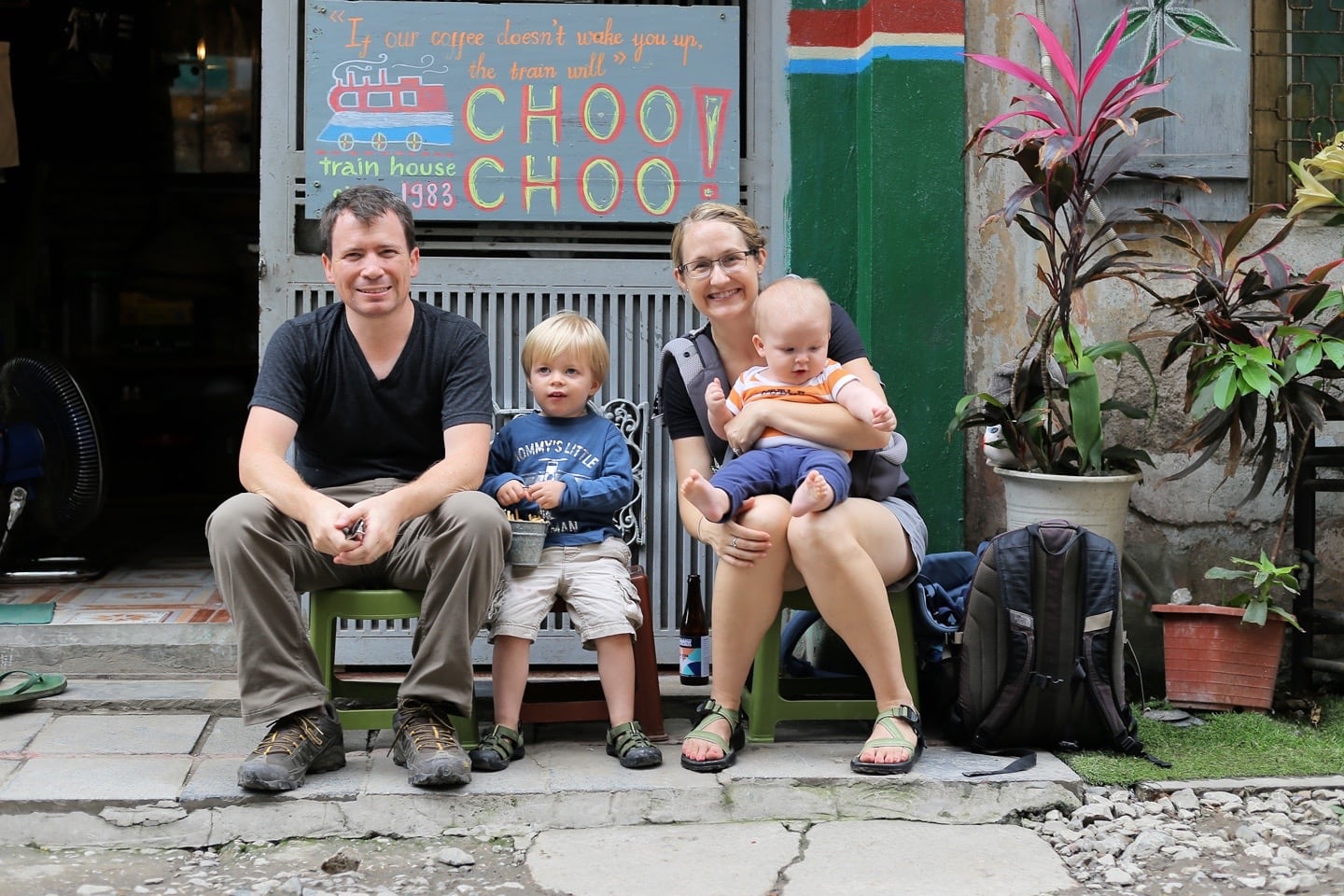
The Railway Hanoi Cafe
We took a seat at the Railway Hanoi cafe and took in our surroundings.
Not long after we sat down, a young woman emerged from Railway Hanoi and asked us if we wanted a drink. We asked to confirm that the train was still coming and she told us that the train wasn’t due to arrive until later that evening and referred us to the schedule on the wall.
Oh well, guess I’ll have a Furbrew.

There are several places to grab a coffee or beer on Train Street, but we’d definitely recommend checking out Railway Hanoi. The staff were friendly and relaxed, and they even offer local craft beer from Furbrew. I have nothing against Bia Hanoi, but welcome variety when I can get it.
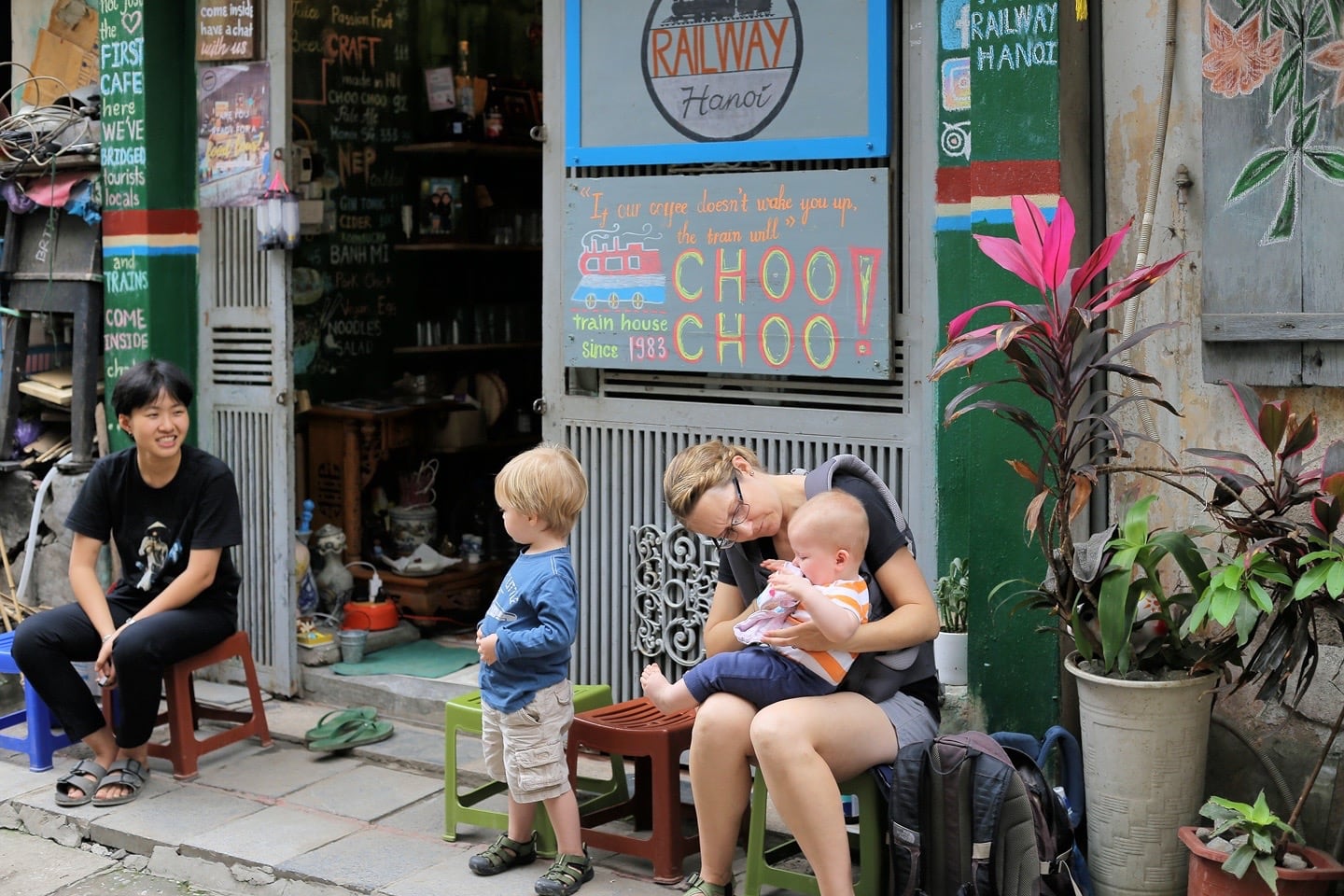
We sat for a while and chatted a bit with the barista, who had taken a liking to Noe and given him a bucket of munchies (everyone’s always giving the kid food in Hanoi, so much that he’d probably have no problem surviving on his own until he’s a teen…then, God help him).
Looking around, it was clear that many of the street’s residents had turned parts of their homes into cafes, bars, and handicrafts shops. We felt no pressure to shop, and everyone we encountered was quite friendly to us.
Of course, kids help in this respect, particularly in Vietnam. But still, we saw nothing but smiles (ambivalence, at the very least) and definitely none of the yelling or chasing out that was apparently a common occurrence at some point in recent years.
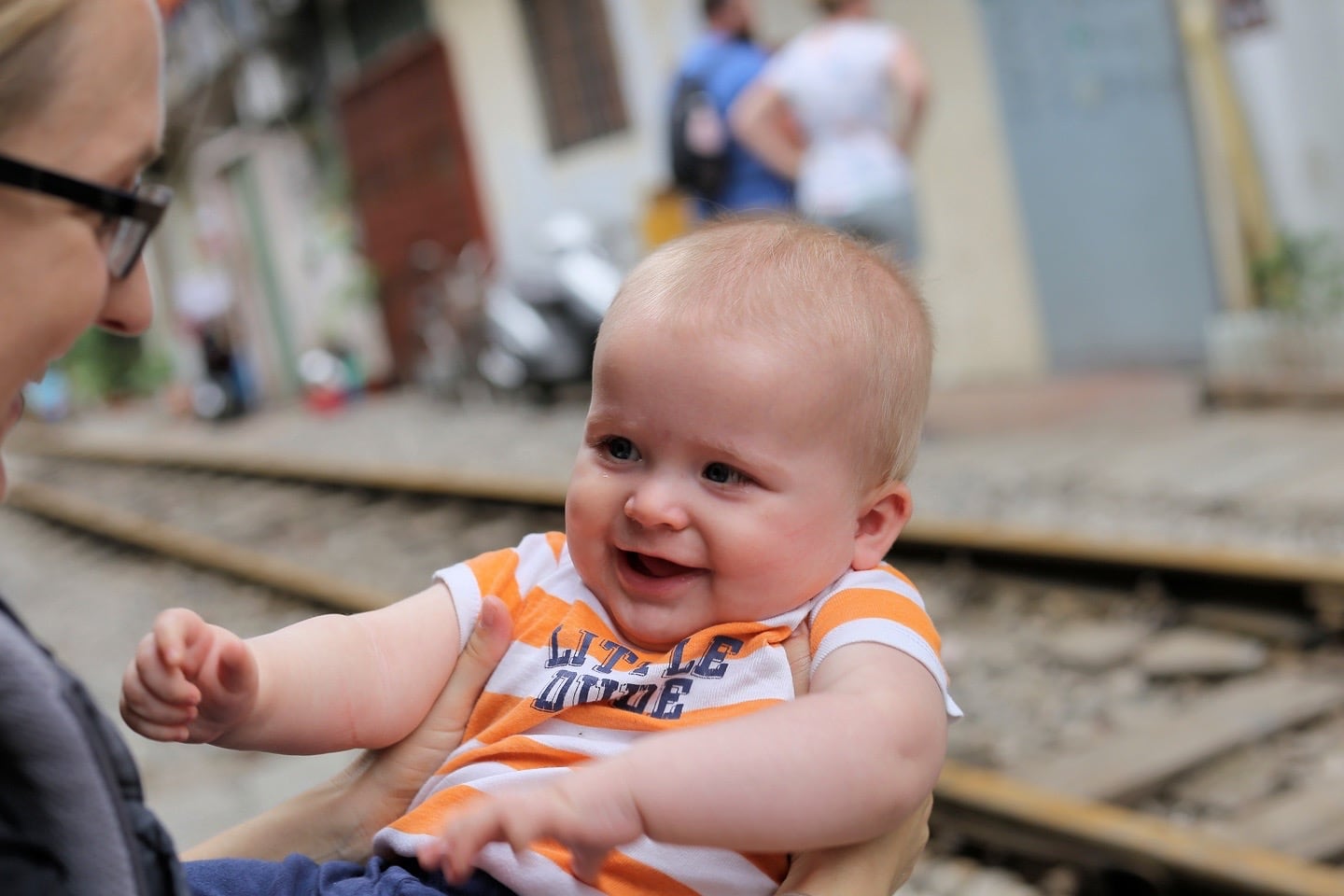
It seems that most locals here have embraced their fate and even made efforts to capitalize on it, which is in line with what we’ve seen across the city, for better or worse. If you can’t beat ’em, make money off ’em, I guess.
Perhaps even more surprisingly, however, was the fact that most of the doorsteps along Train Street remain purely residential, with residents continuing to go about their daily business with or without tourists clammering about.
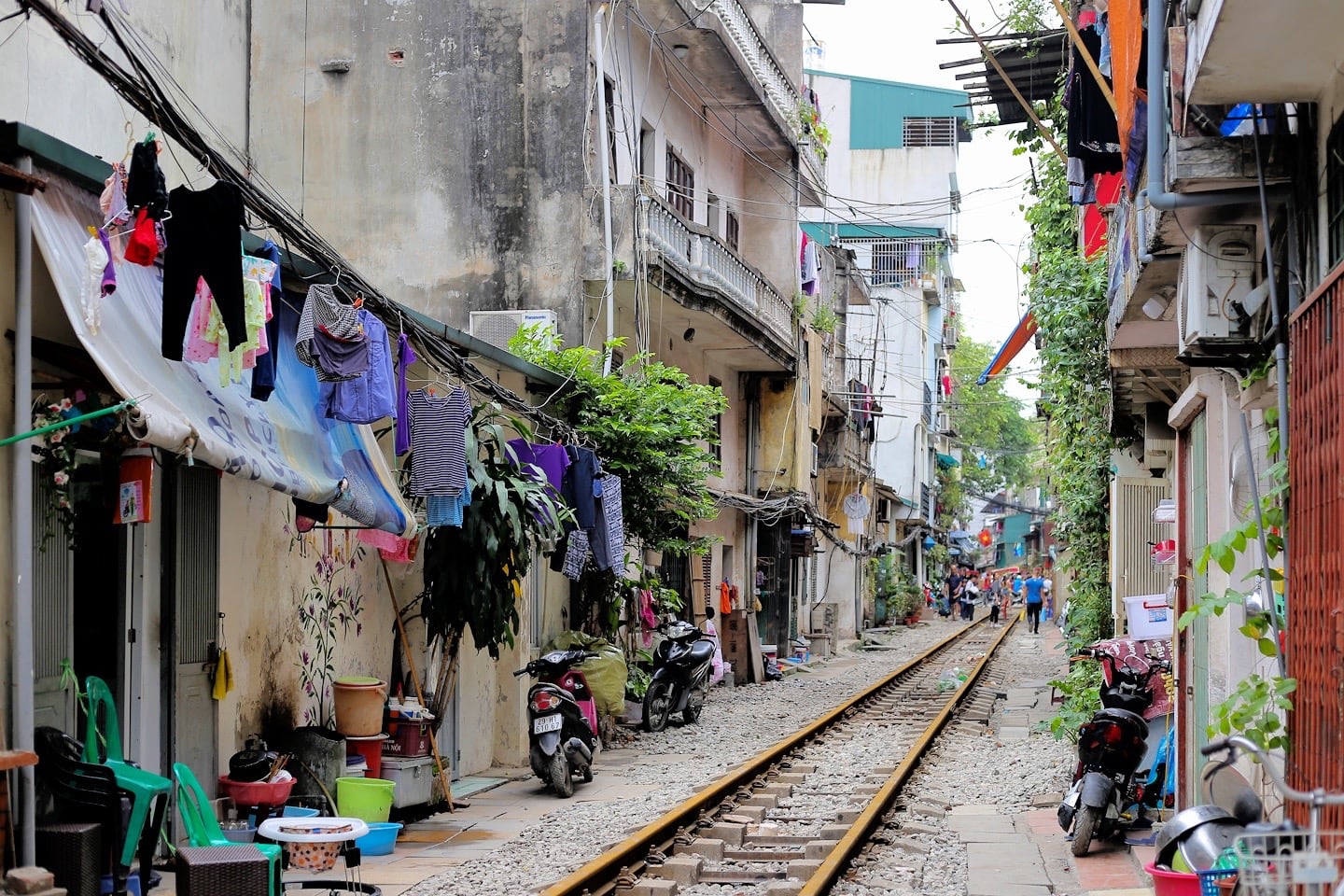
While we sipped on our beer and relaxed, a large organized group of some sort streamed through the small alleyway. As there was no train scheduled until the evening, I can only assume that this was the part of the tour where the guide says something like,
“This is Hanoi Train Street. Okay, then. On to Ho Chi Minh’s Mausoleum!”
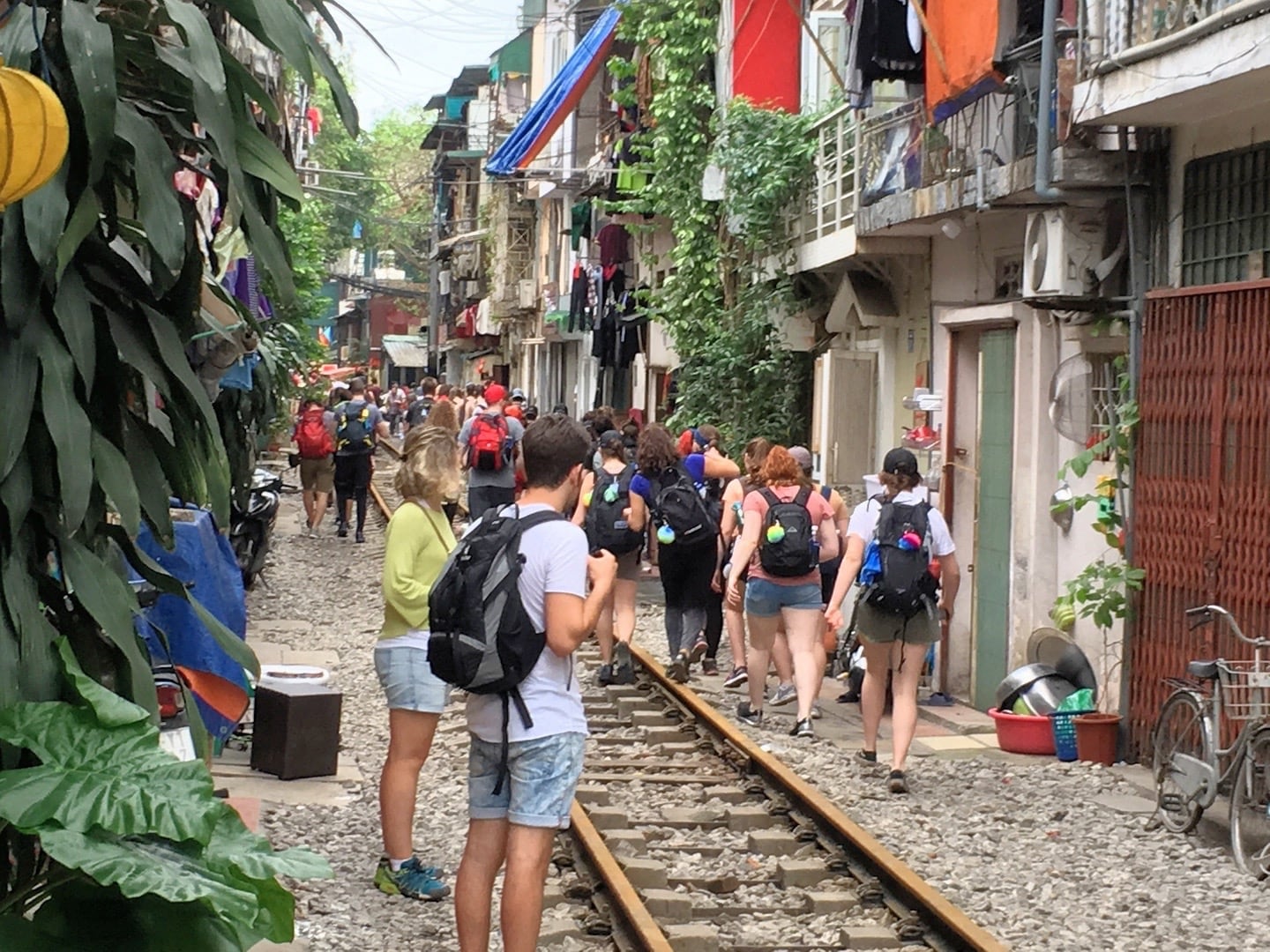
We finished up the beer, took a few day time photos without the fear of a locomotive flattening us, and carried on, hoping that we’d be able to work in a return trip with an actual train sighting.
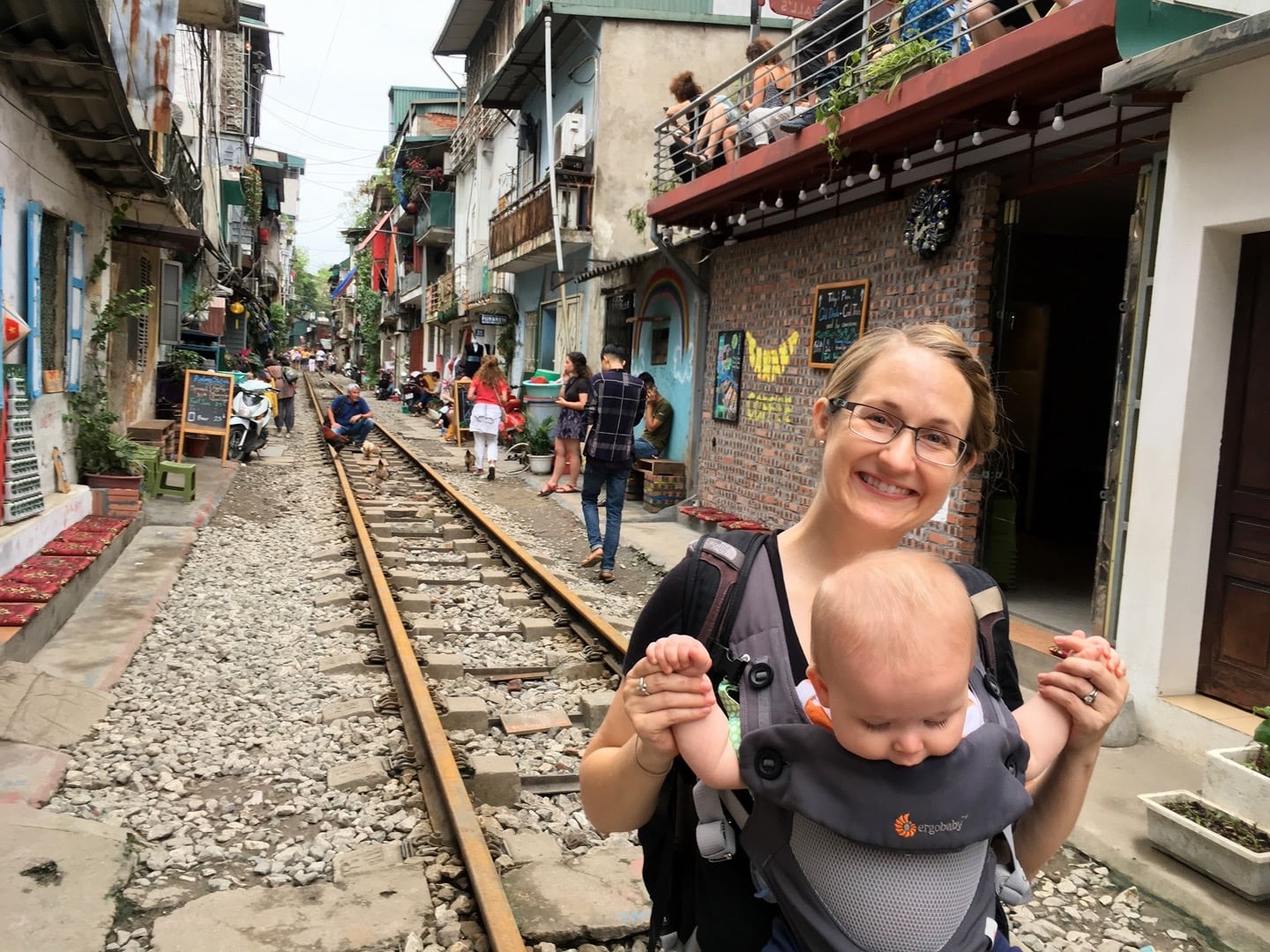
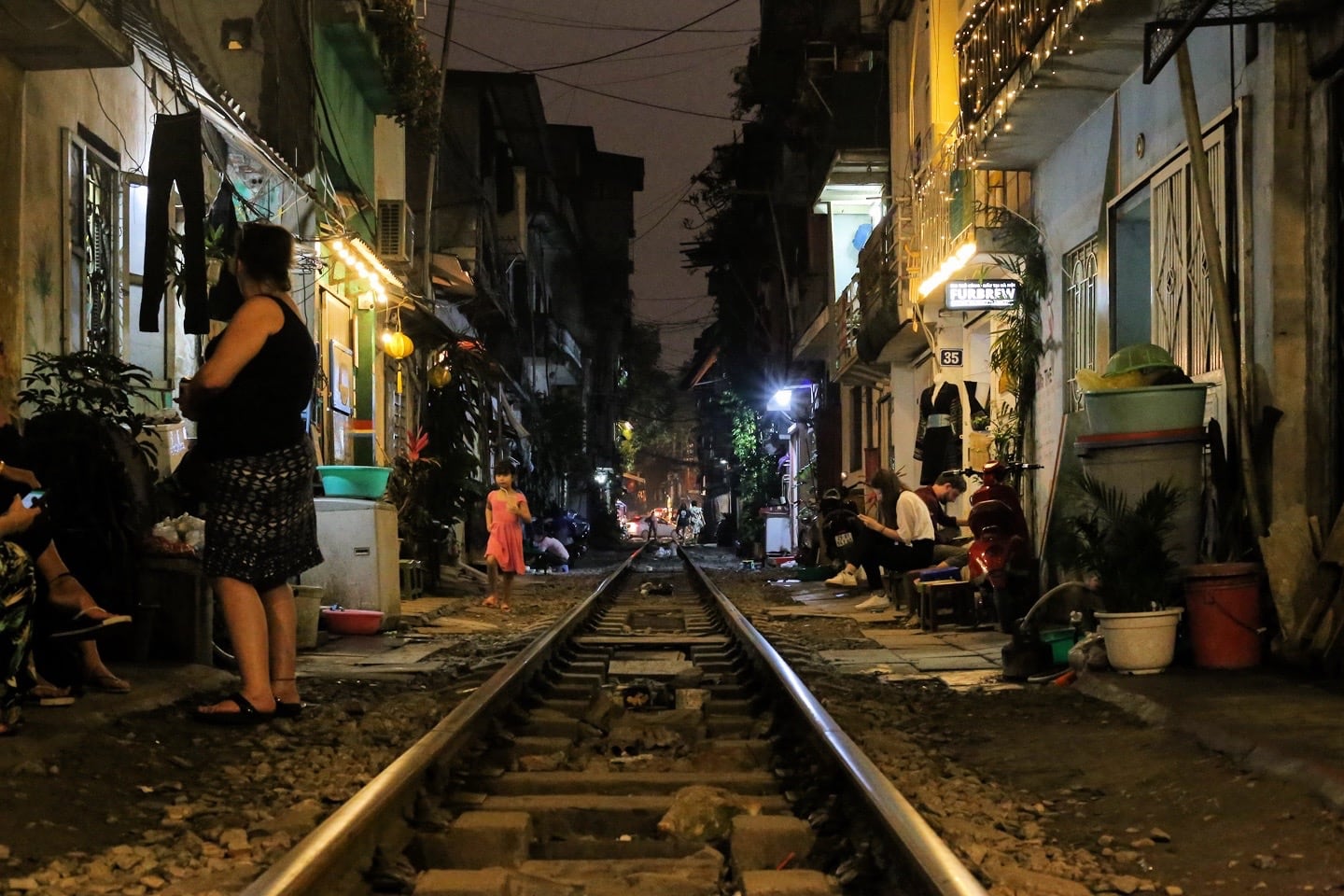
Hanoi Train Street by Night
We got our chance the next evening. Both boys were in a good place after a delicious meal of Bun Cha (who wouldn’t be?). Lori and I each hoisted a boy on our backs and made our way back up to Train Street from French Quarter on foot, which is no small feat in the tropical heat, even at night.
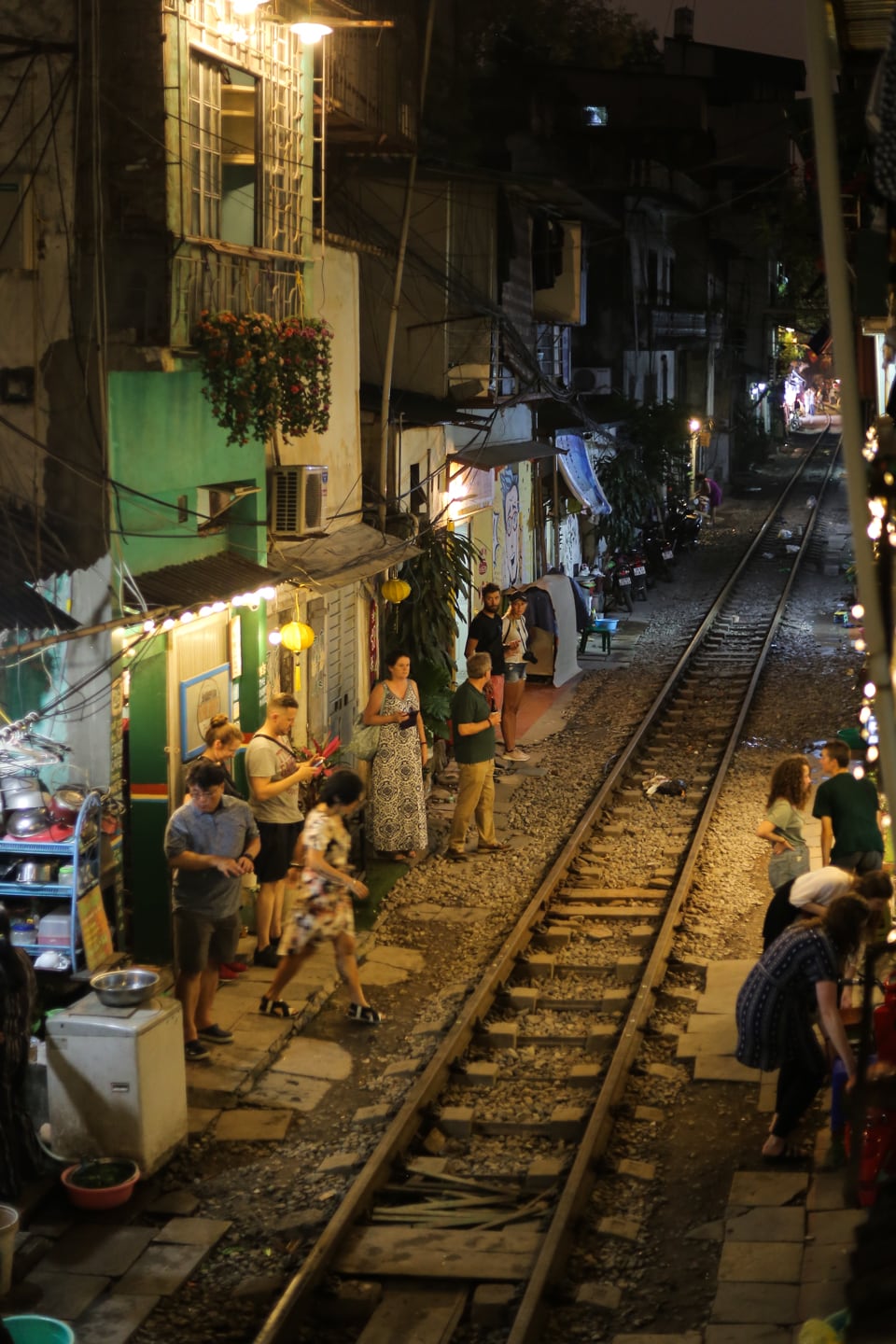
RailwayStation Cafe
We arrived with just minutes to spare. Knowing what we knew now, we decided the best place for the boys would be up on the second-level balcony at RailwayStation Cafe, which had plenty of seating. I guess that’s the benefit of showing up midweek for an evening train sighting.
RailwayStation Cafe is a great place to view the trains with kids. Not only do they have coffee, beer, and snacks, they have two sides of the track to choose from, AND an upper balcony, to keep the little ones out of the way of the 200-ton locomotive rolling through. Just watch those hands!
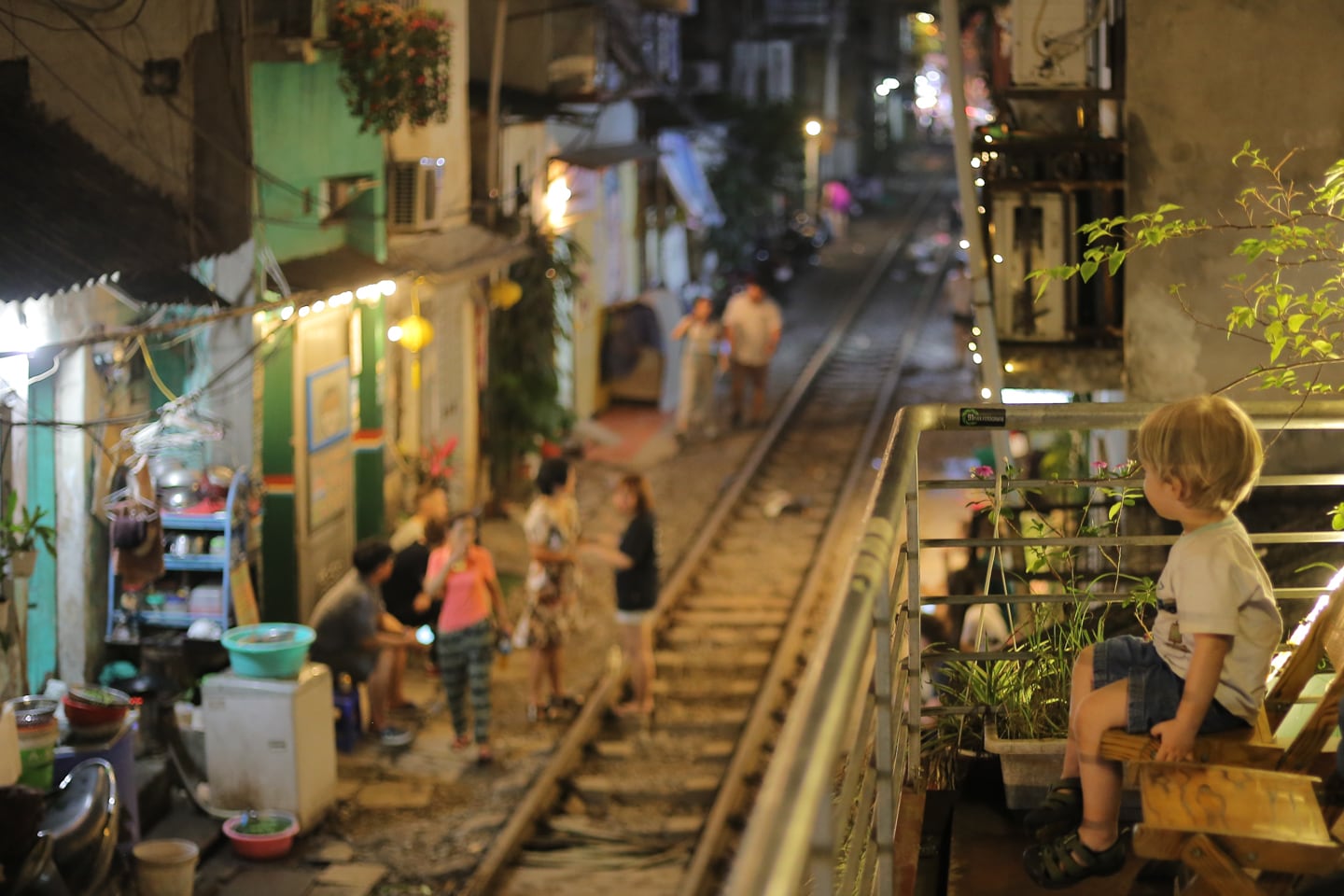
We thought this perch was a foolproof place for a toddler to watch a full-size locomotive go by, but later discovered it’s by no means foolproof. If you visit with young kids, just be aware that the train literally passes within inches of that guardrail and all hands and feet most definitely need to stay clear of it.
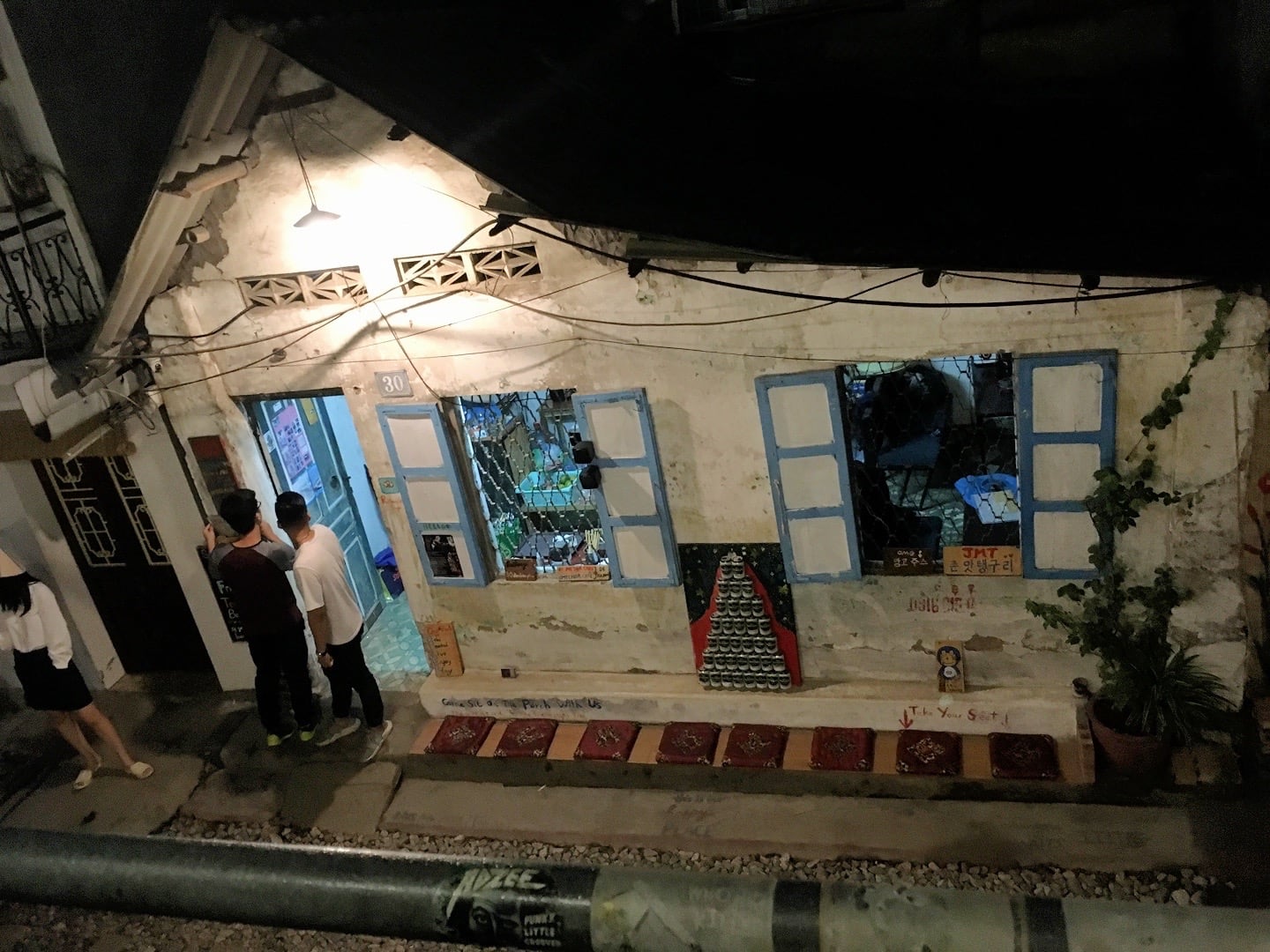
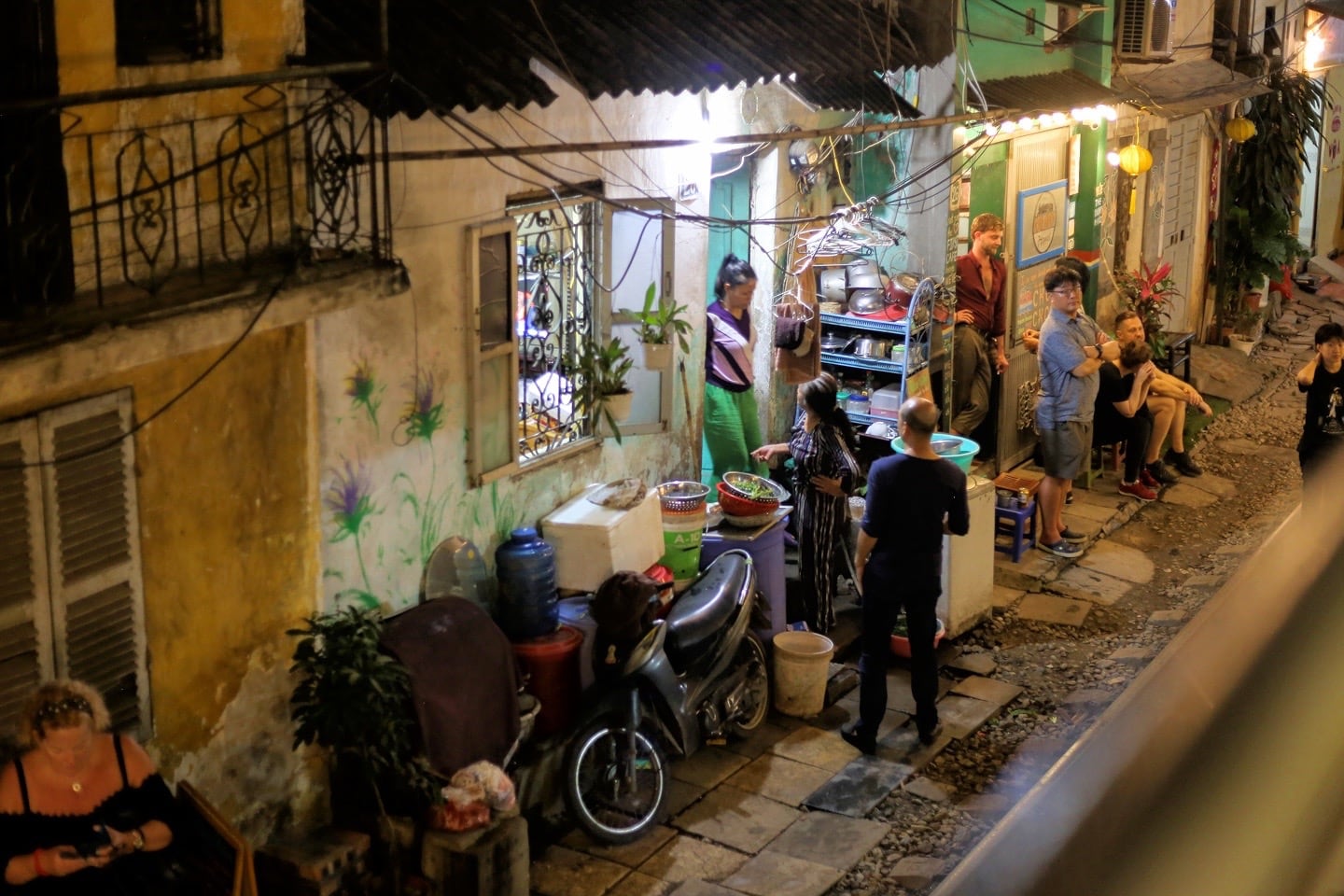
The train was running a little late, which wasn’t surprising. This isn’t Japan, after all (few places are). And, judging by the direction everyone was looking, this was an inbound train nearing the end of the line.
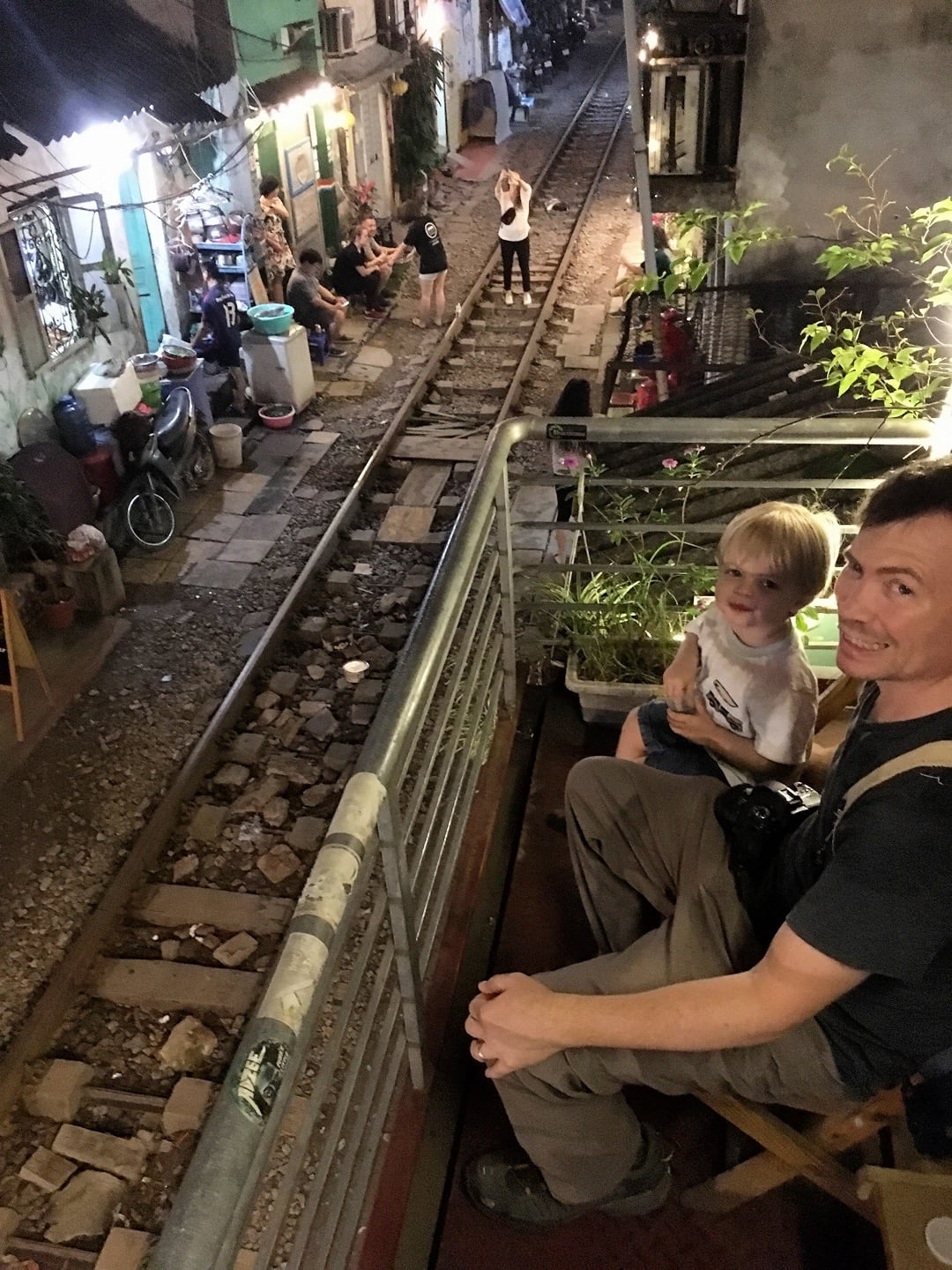
We enjoyed watching (and listening to) a local tour guide below giving some history on the train and explaining what was going to happen.
Just before the train arrived, traffic was blocked at the street crossings on both sides of the neighborhood, and workers in bright orange vests appeared out of nowhere to make sure motorbikes and pedestrians don’t try to bypass the crossing gates.
Then, the unmistakable blare of the train horn, followed by a bright light in the distance.

I was fully aware that full-sized locomotives roll through here, but was still shocked by the size of the thing now rolling towards us.
I had only seen pictures and video of the train in the day time. Maybe the dark makes it appear larger? Maybe seeing it in person is the only way to grasp the scale of what we’re witnessing — a passenger train rolling along at 15 km/h (10 mph) through a populated alleyway with less than a meter of clearance on each side in some spots.
15 km/h might not seem fast to you, but trust me, it’s fast enough to do some serious damage if you’re unfortunate enough to find yourself on the business end of this thing while it’s moving through.
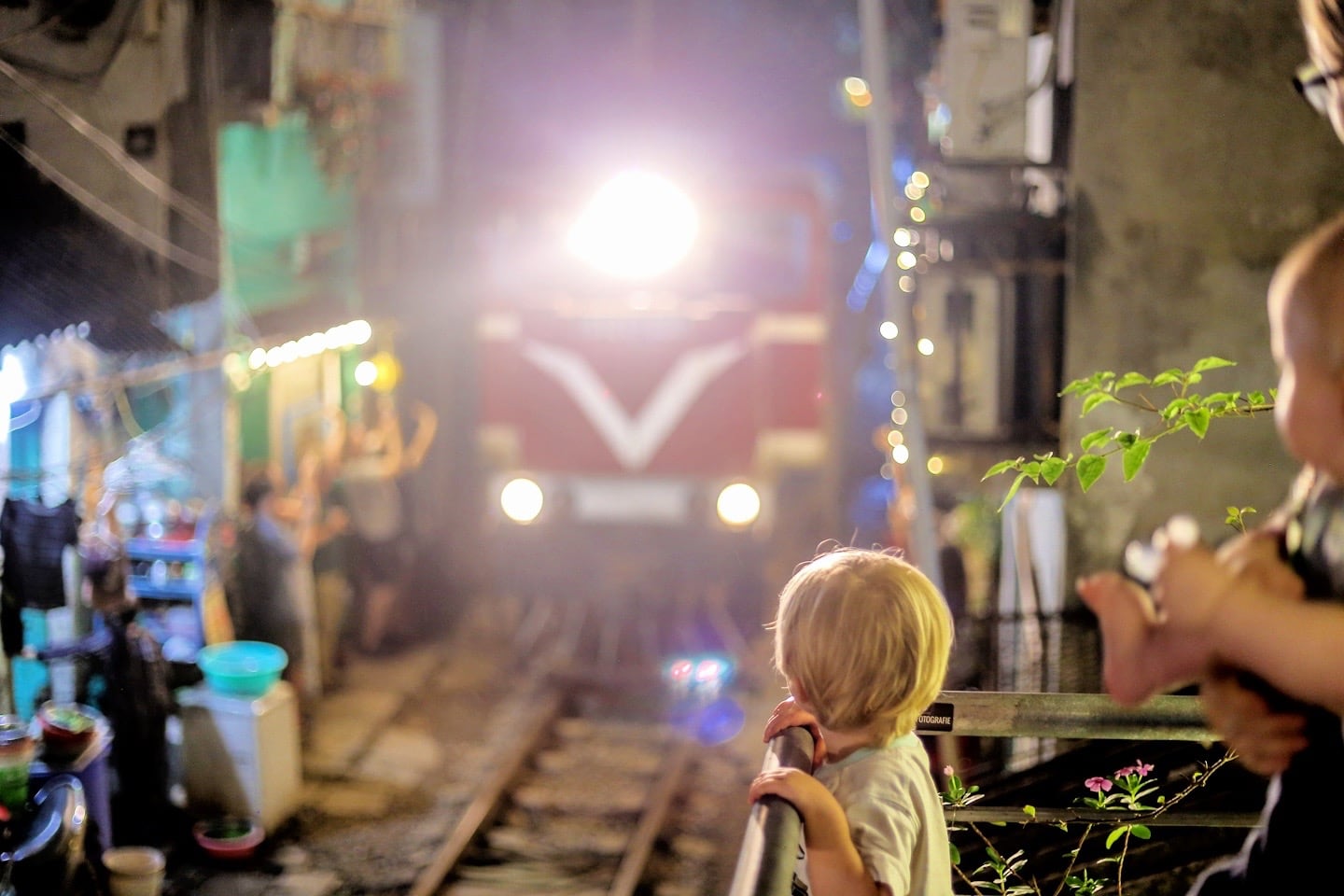
Once we realized just how little clearance there actually was between the train and the balcony railing, we pulled Noe back a bit. Fortunately, he’s a very good listener when it comes to this kind of stuff, but we like to err on the side of caution when our activities happen to involve a moving locomotive.
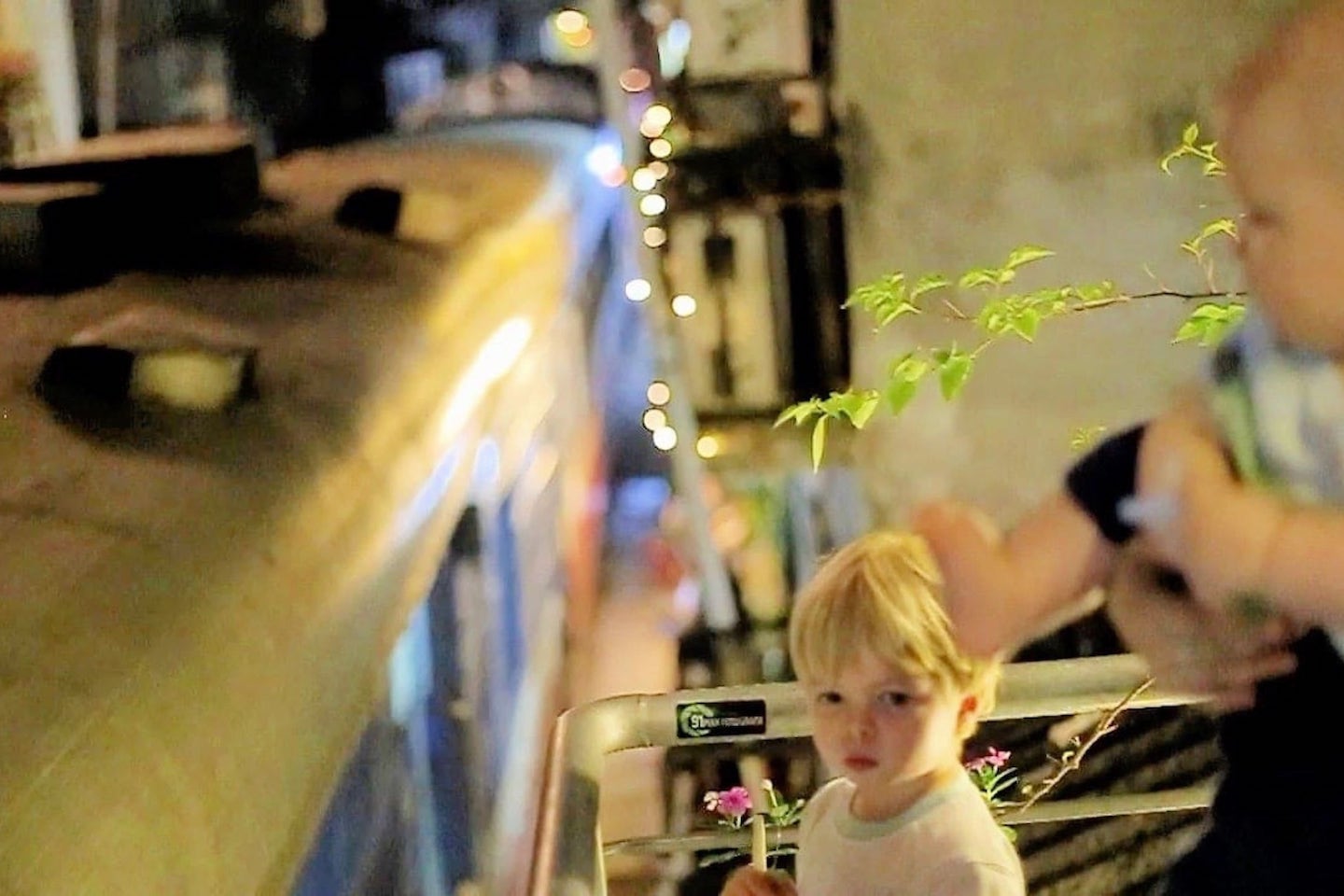
And less than a foot of clearance between the train and our balcony. You definitely want to keep all hands and feet in the ride at all times.
The train was a long one, taking a couple of minutes to clear out. I have to say, as tourist-oriented as the street has become, it was very much worth the visit. A one-of-a-kind experience that’s getting harder to find as the years go on. And, a pretty darn awesome one at that.
But that’s not the end! The server came up to tell us A SECOND TRAIN was due to arrive in 20 minutes. Double feature!
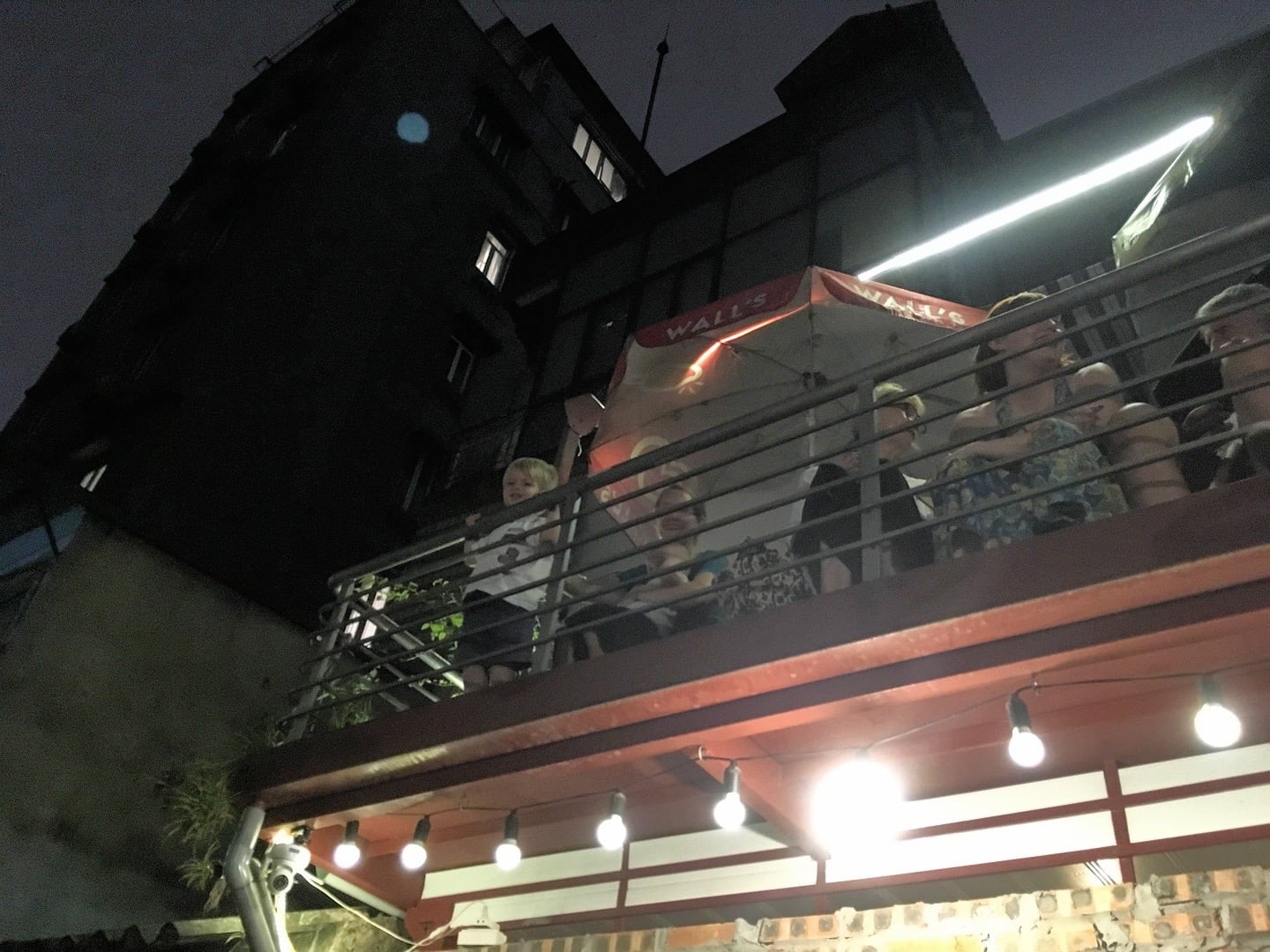
For the second train, I left Lori and the kids in the relative safety of the balcony and headed down to street level where the real action is.
Minutes later, the second locomotive came rolling in (this time, a short freight train), all while residents (like the woman below) went about their nightly household activities as usual.
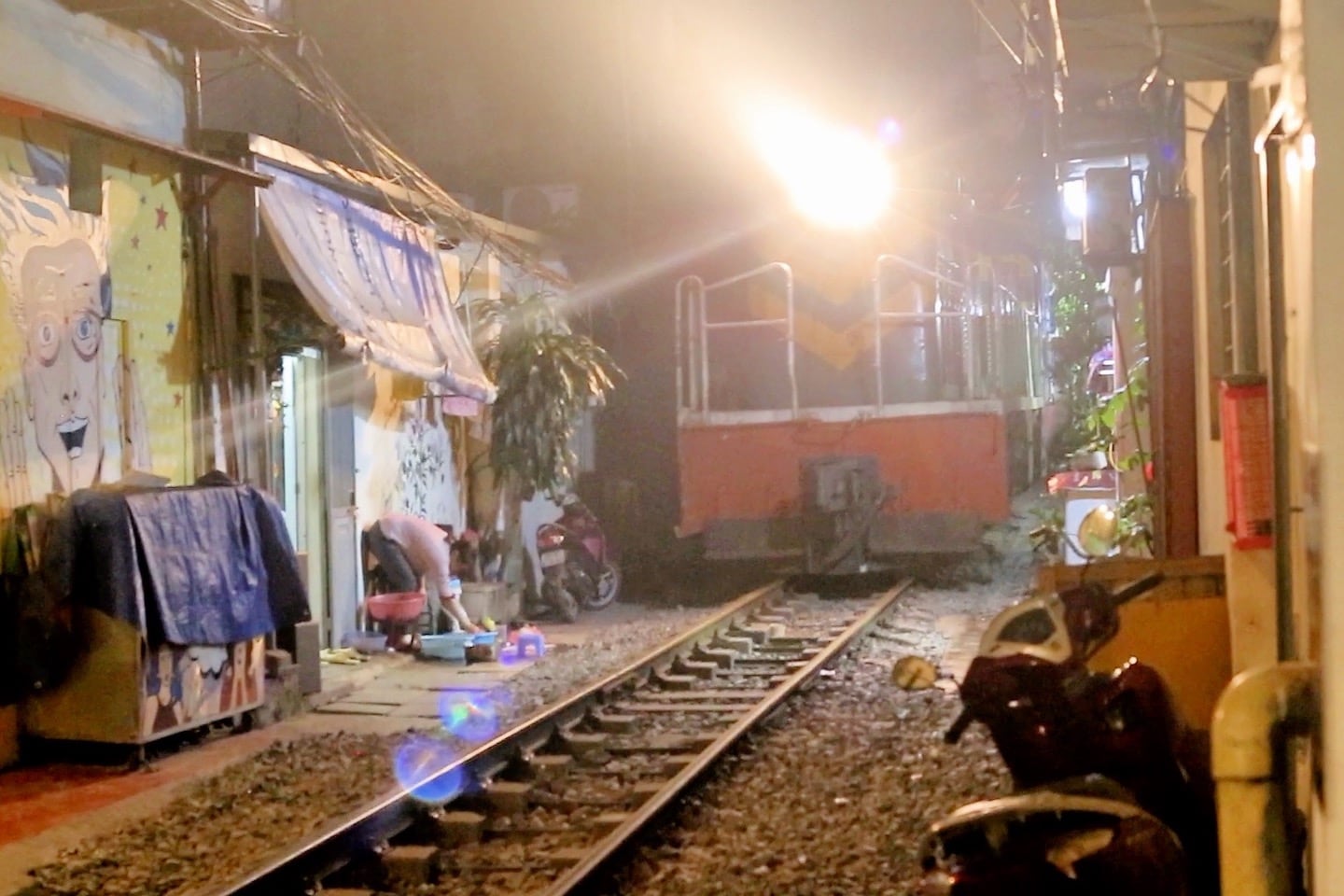
“I don’t care if there’s a freight train coming through my front porch, these dishes are going to get finished!”
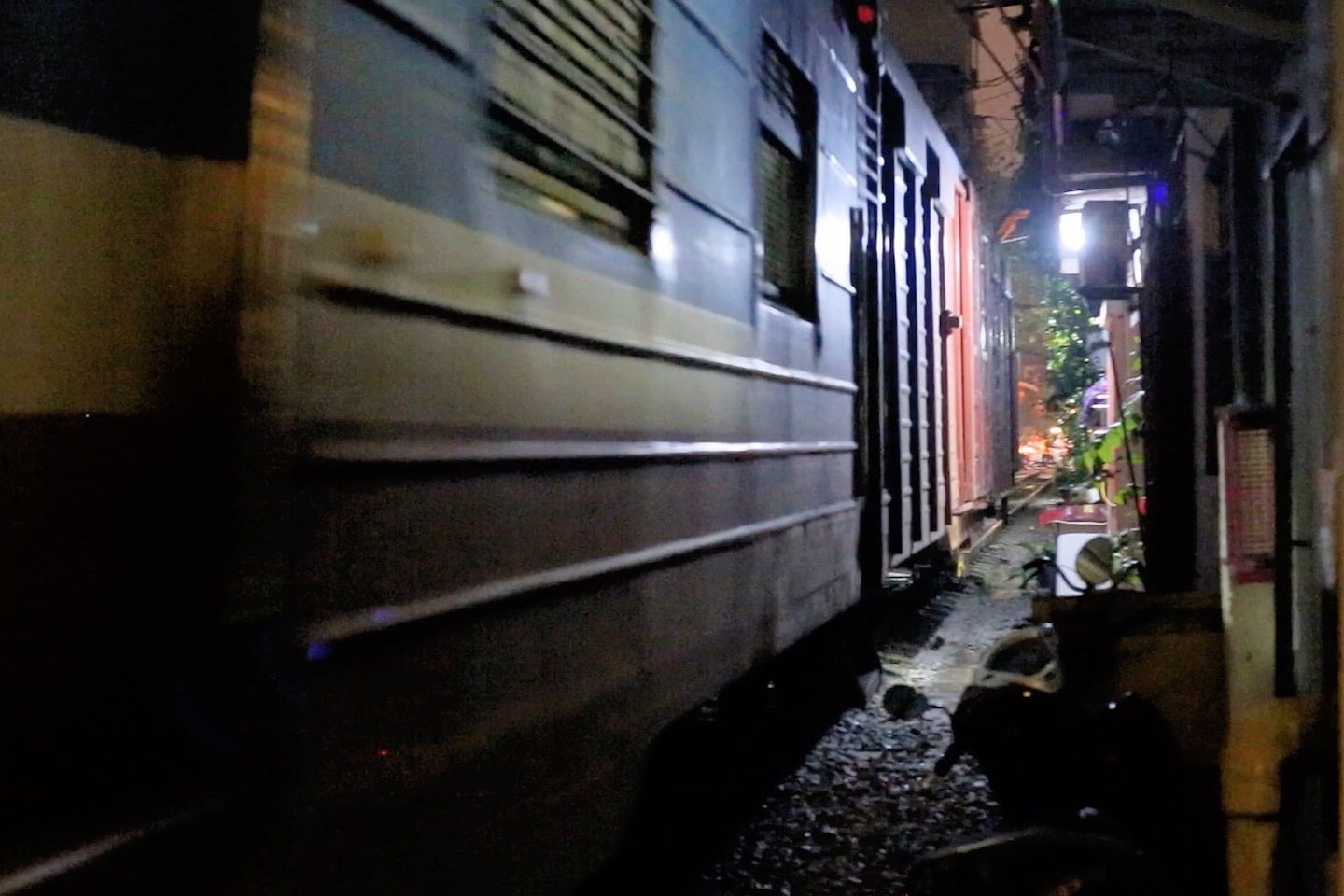
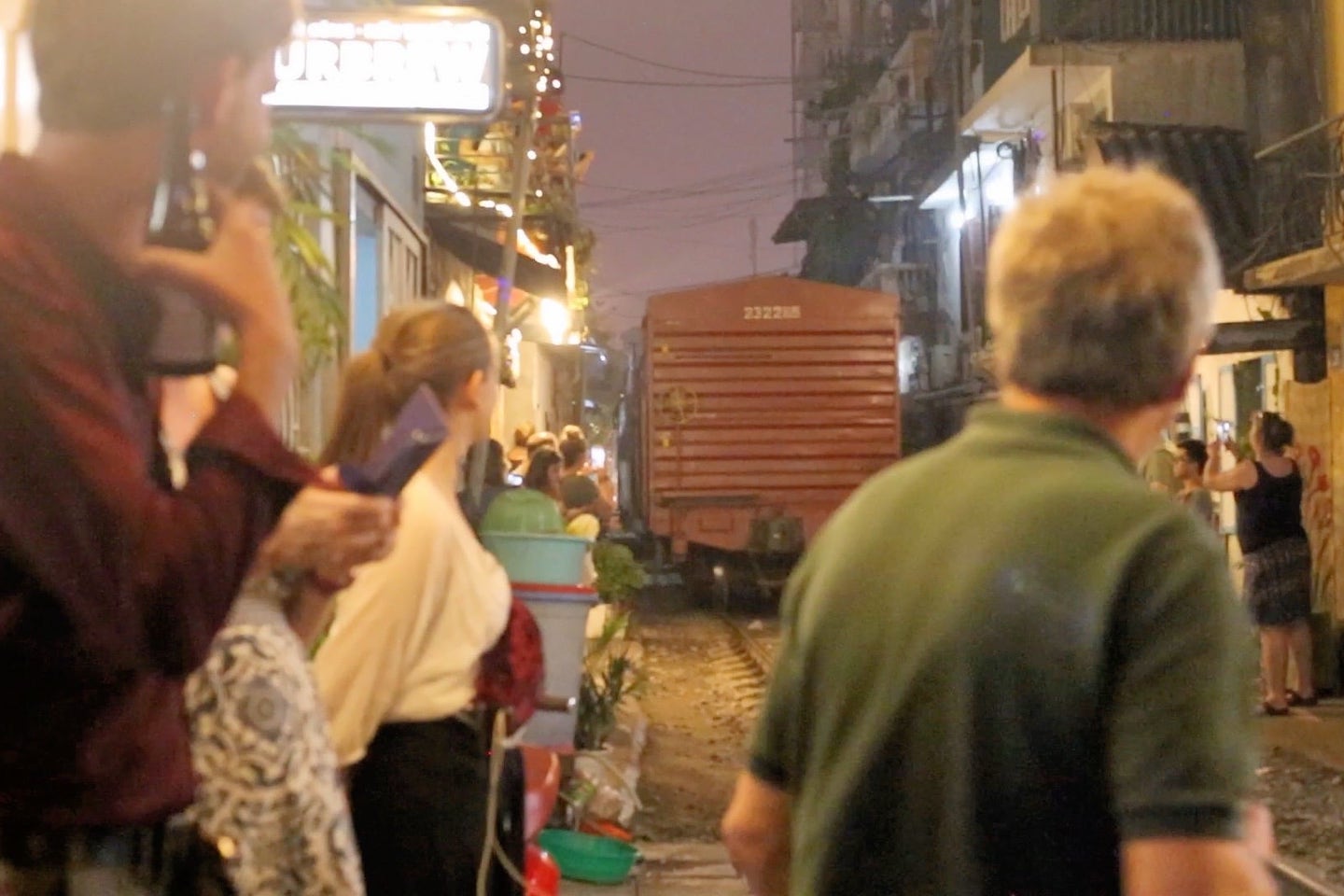
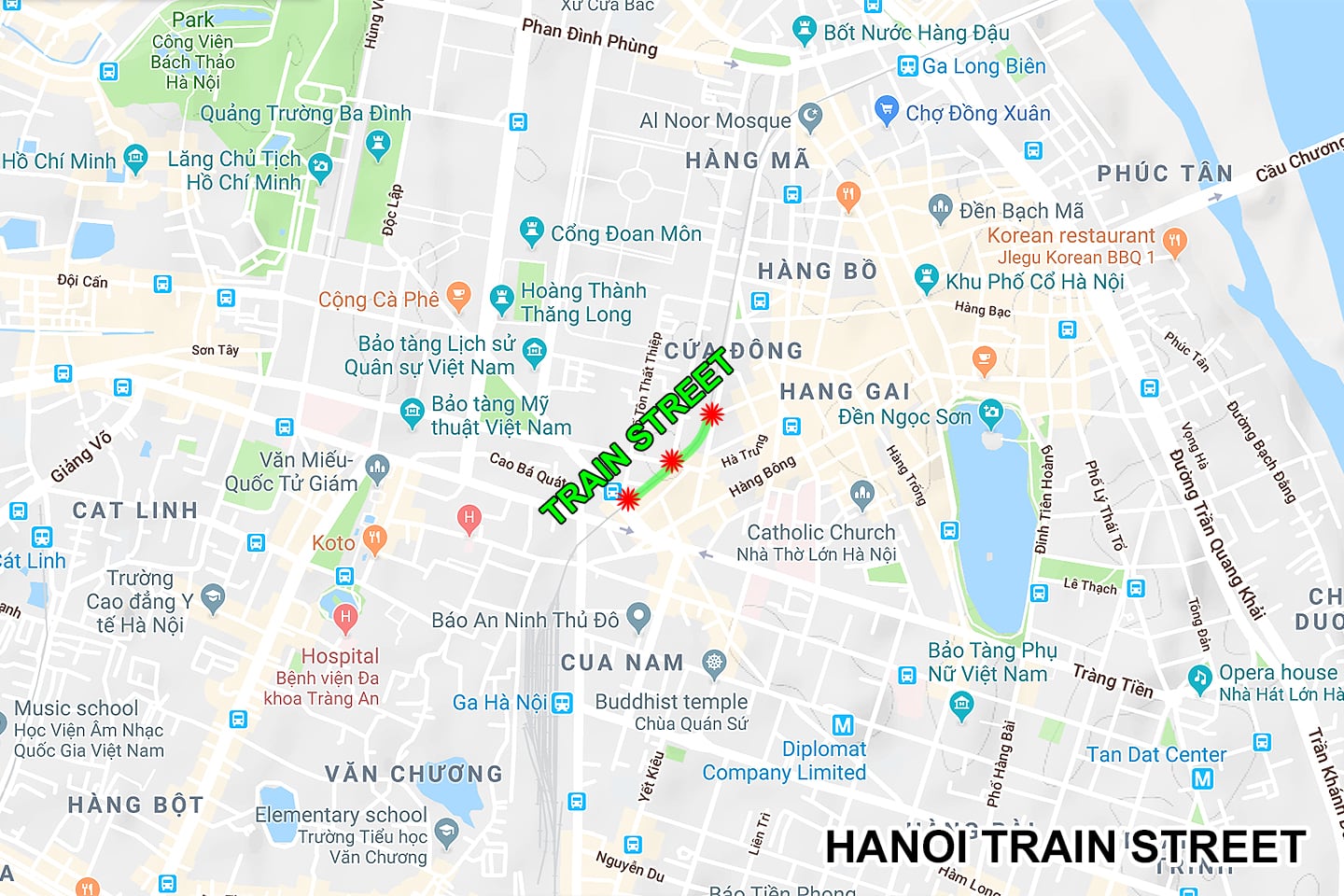
How to Get to Hanoi Train Street
Getting to Hanoi’s Train Street is probably easier than you think. If you’re up for a walk, Train Street is conveniently located halfway between St. Joseph’s Cathedral and the UNESCO World Heritage Site of Thang Long Imperial Citadel and Vietnam Military History Museum, from where you can easily continue on to the Ho Chi Minh complex.
If you search for Hanoi Train Street in Google Maps, it will send you to the point where the tracks cross Tran Phu. For most visitors, however, it probably makes the most sense to access Train Street at its southwestern end, where it intersects Dien Bien Phu (GPS: 21.029127, 105.842703). If you get a GrabCar, this is what you would enter as your destination.
Outside of train times, the road is closed to through traffic. Being that people’s homes are located along this alley, however, you’re bound to see the occasional motorbike clumsily making its way along the loose gravel surface of the thoroughfare.
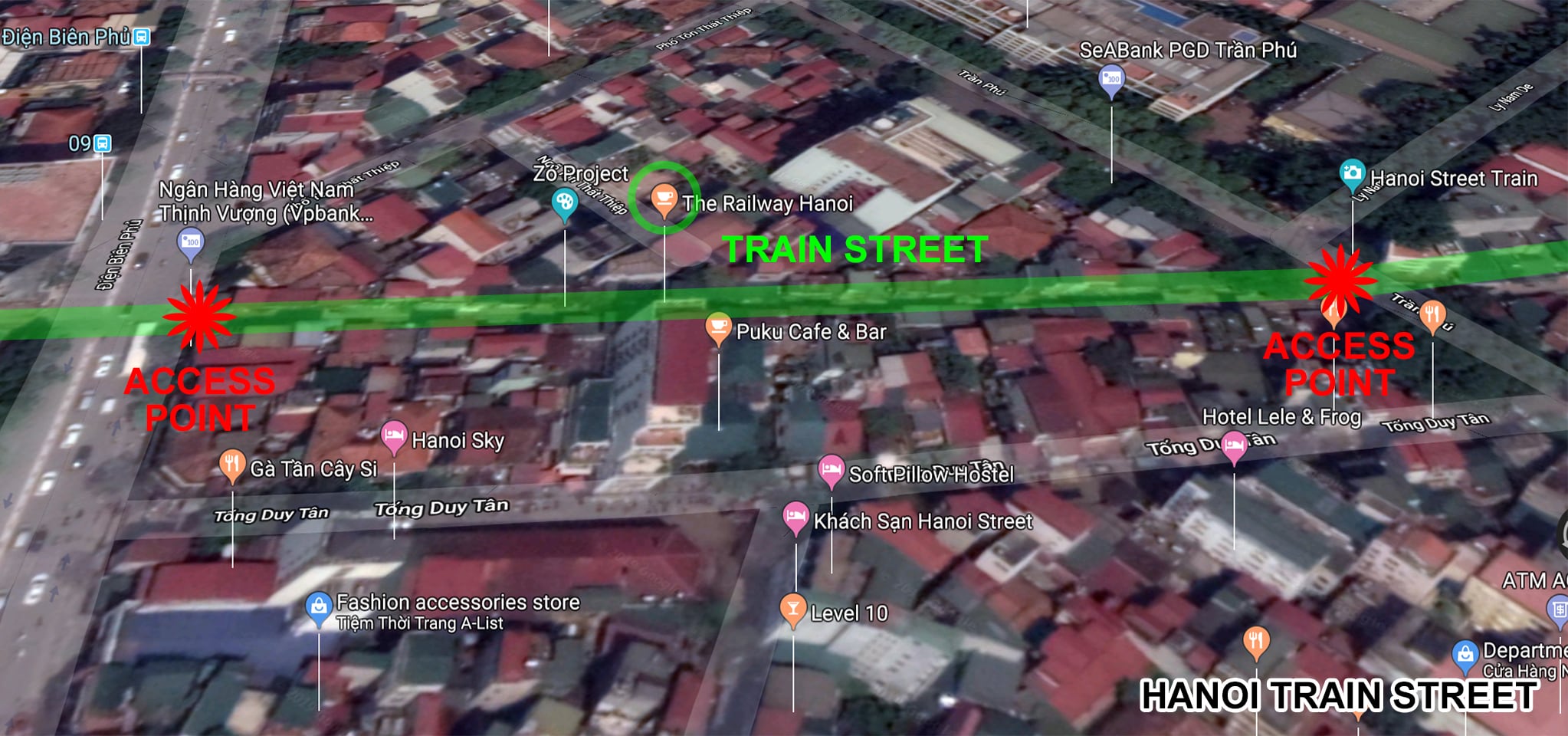
Hanoi Train Street Schedule 2019
Looking for current Hanoi Train Street times? You’ve come to the right place! See below.
It’s important to note that there is no railway station or stop along Train Street, so residents have put together this estimated timetable on their own.
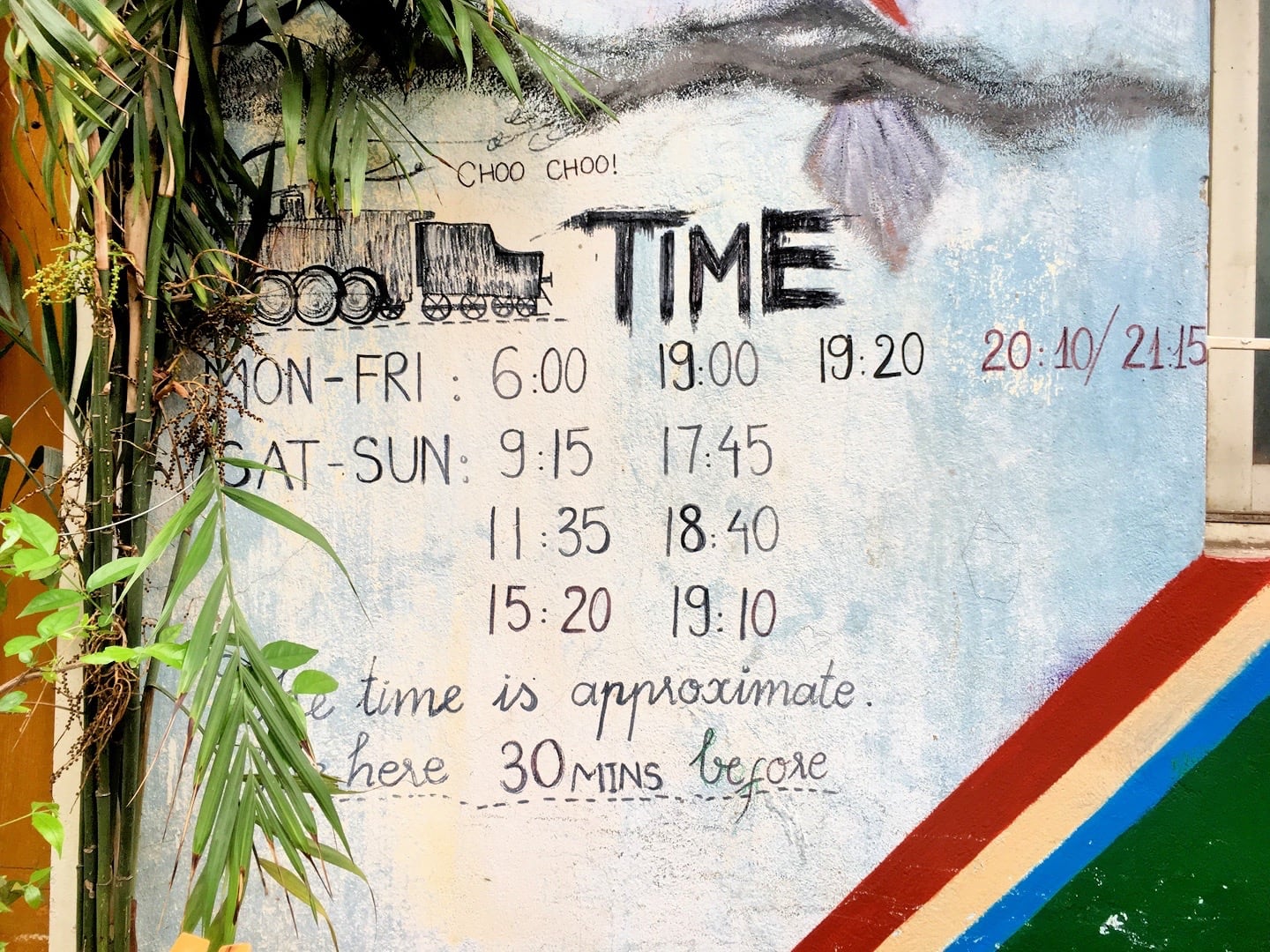
This was the schedule while we were in Hanoi (current as of April 2019). In case the image above doesn’t load, I’ve included them below as well:
MON-FRI 06:00 19:00 19:20 20:10/21:15
SAT-SUN 09:15 11:35 15:20 17:45 18:40 19:10
As noted, times are approximate, and it’s recommended you arrive 30 minutes beforehand, as some trains do occasionally arrive early.
(Psst…wondering where to stay in Hanoi? With over 2,000 options in Hanoi for travelers it’s easy to feel overwhelmed. We’ve got you covered with our independent recommmendations below.)
Know Before You Go
Is Hanoi Train Street safe? Well, that depends on what you consider safe and when you choose to visit. It’s as safe as anywhere else in the city when visiting outside of expected train times — probably even safer given that it’s one of the few roads in the city where there’s little chance of getting run down by a motorbike. When trains do arrive, there is generally a fair amount of warning. With that said, a few things to keep in mind:
Give the rail cars lots of space — Like anywhere, when locomotives are present, it’s best to exercise extreme caution and stand clear. There is a safety line painted in front of some of the cafes and bars. Stay behind it until the entire train has completely rolled past you. Cars sway quite a bit and some have appendages that stick out.
Exercise common sense on Train Street — A locomotive approaching on train tracks is not the time for selfies! A selfie on the tracks is fine well outside of train times (which is most of the time), but not when a train is approaching. It’s probably not a good idea to take one while standing on the sidelines either, as hardware does protrude from the train.
Watch your alcohol consumption — As mentioned, residents seem to be doing a bang-up job of capitalizing on the influx of tourists, particularly those selling alcohol. While I enjoy a cold beer as much as anyone (and in fact sipped one during our visit to Train Street), the number of places pushing alcohol on Train Street was concerning and suspect there will be issues down the line as visitor numbers grow. When we returned to see the train in the evening, we saw a group of very inebriated middle-aged European tourists down on the tracks minutes before the train came. All I’ll say is you probably want your wits about you when a 200-ton locomotive is coming towards you.
The 15:20 train seems to be the most popular — If you plan on visiting on the weekend for the 15:20, make sure you arrive extra early if you want a good seat, particularly for the choice seats on the second-floor balcony of RailwayStation Cafe.
Restaurants, Bars & Cafes — There are a handful of local eateries along Train Street that do a good business and look pretty tasty. One street to the south is Tong Duy Tan, a food alley with numerous restaurants. If you don’t feel like street food, Puku Cafe & Bar on Tong Duy Tan is a very good option. As mentioned before, there are a number of places serving alcohol along Train Street. We enjoyed our second-story perch from RailwayStation Cafe, and the Bia Hanoi was cold and tasty. If you’re in the mood for craft beer, The Railway Hanoi serves Furbrew local craft beer. But be warned, you will pay a bit of a premium for a small bottle on Train Street.
Hanoi Train Street With Kids
If you’re traveling with little ones, there are a few additional considerations you’ll want to keep in mind for visiting Train Street.
Keep your kids close (and your toddlers closer!) — If you’ve got little ones, don’t mess around here when trains are due to arrive. Don’t take any railing, safety lines or any other safety measures for granted. If safety is a major concern (or you have a kid who’s a bit of a rebel), the safest place to watch the train is probably through a window from inside one of the cafes. The second safest place is probably the balcony on top of RailwayStation Cafe, provided that you keep hands and feet well inside the railing at all times.
Restrooms — There are toilets located inside RailwayStation Cafe (under the stairs) and Railway Hanoi.
Motorbikes & Chickens — Outside of train times, the two biggest dangers for small children are the occasional motorbike unexpectedly making its way across the outdoor seating area of your cafe, and…angry chickens. No joke, some of the chickens were quite vicious and nipped nonstop at Noe.
Long Waits — Arriving 30 minutes ahead of time and delays being common spells a lot of waiting. It may be helpful to bring along something to do (and extra snacks) for little ones.
Where to Stay in Hanoi
With over 2,000 options, Hanoi is a lodging paradise! It’s also a beast in terms of finding the right accomodation for your stay, especially if you aren’t familiar with the lay of the land.
Here’s where we would stay if we were planning our own visit to Hanoi.
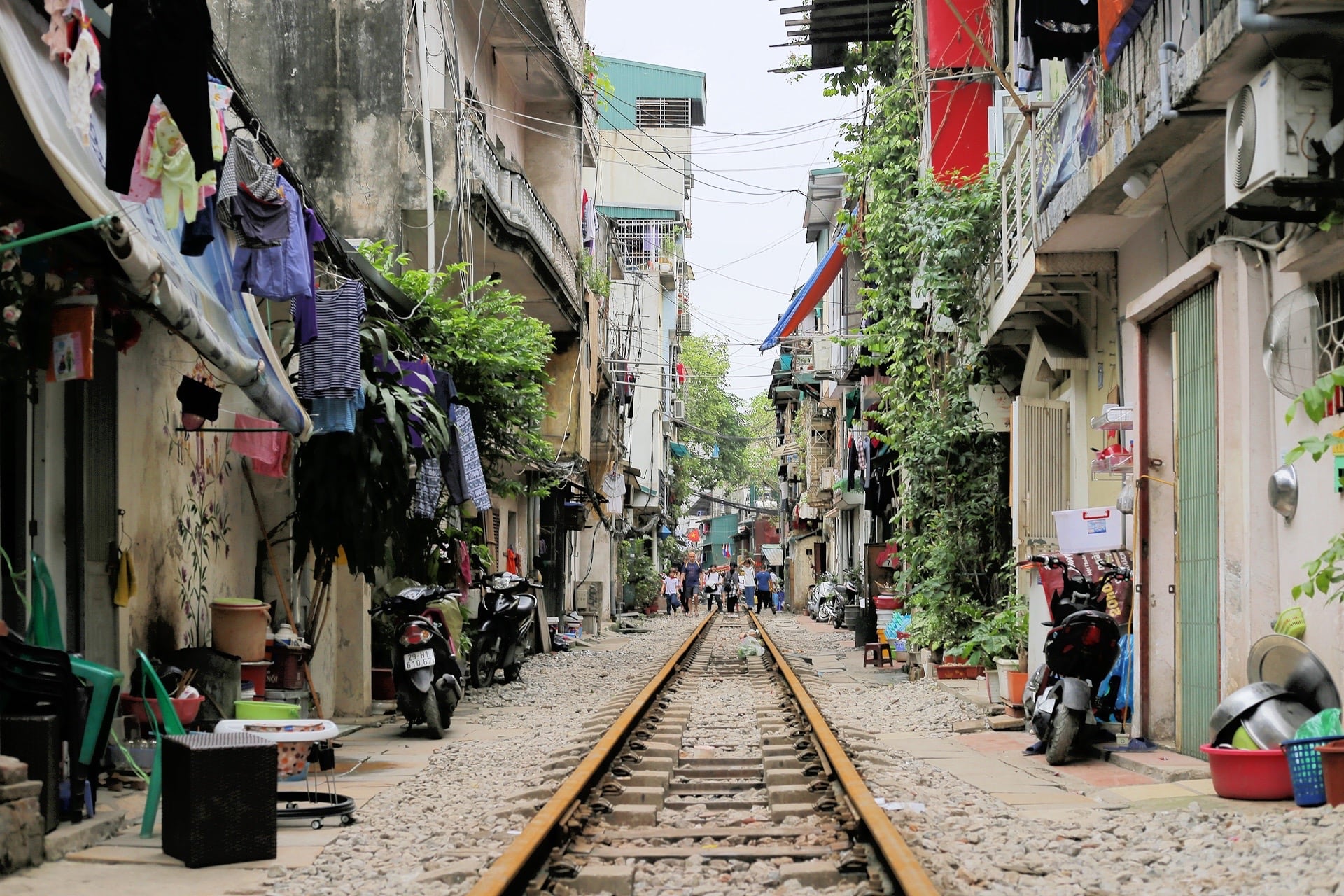
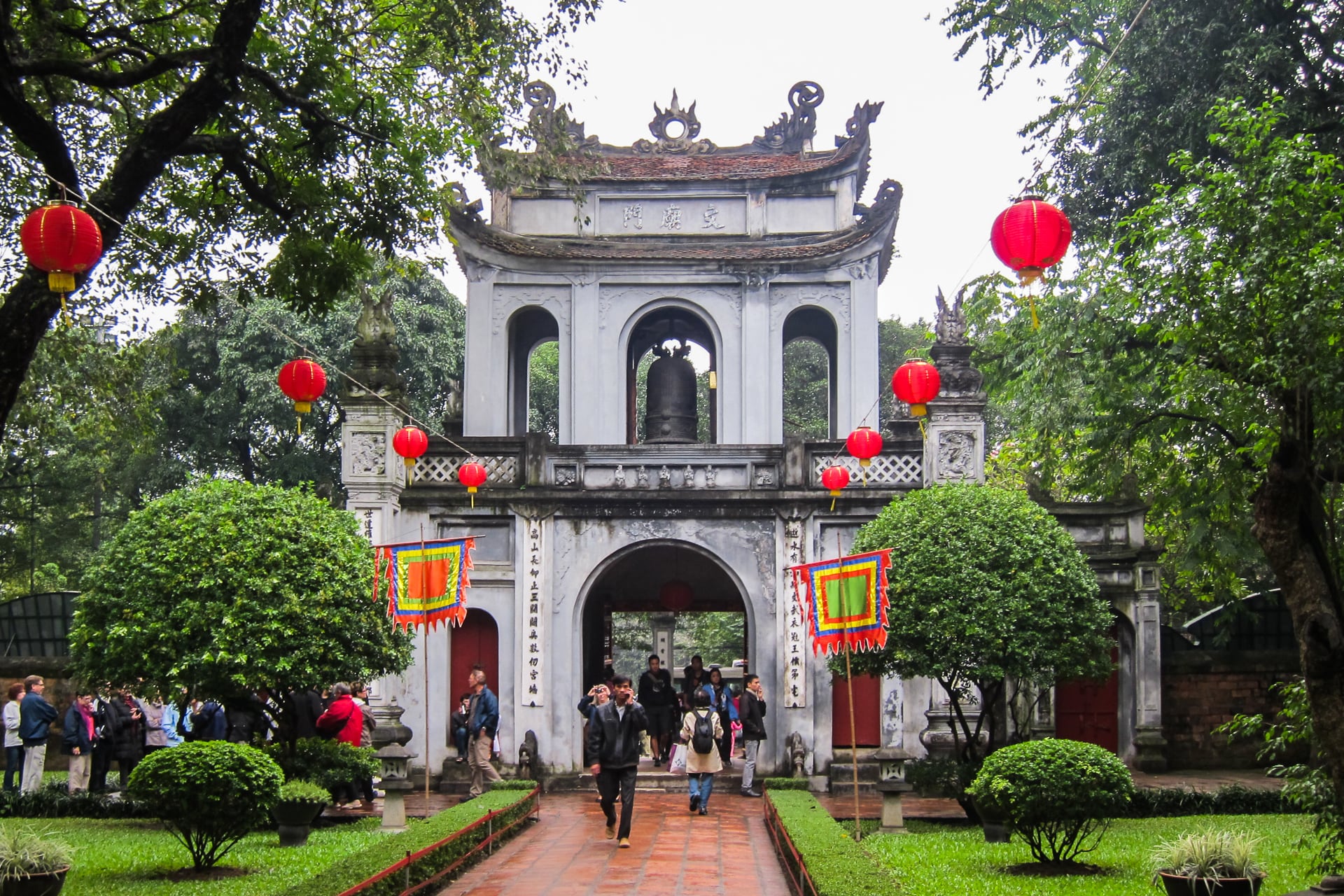
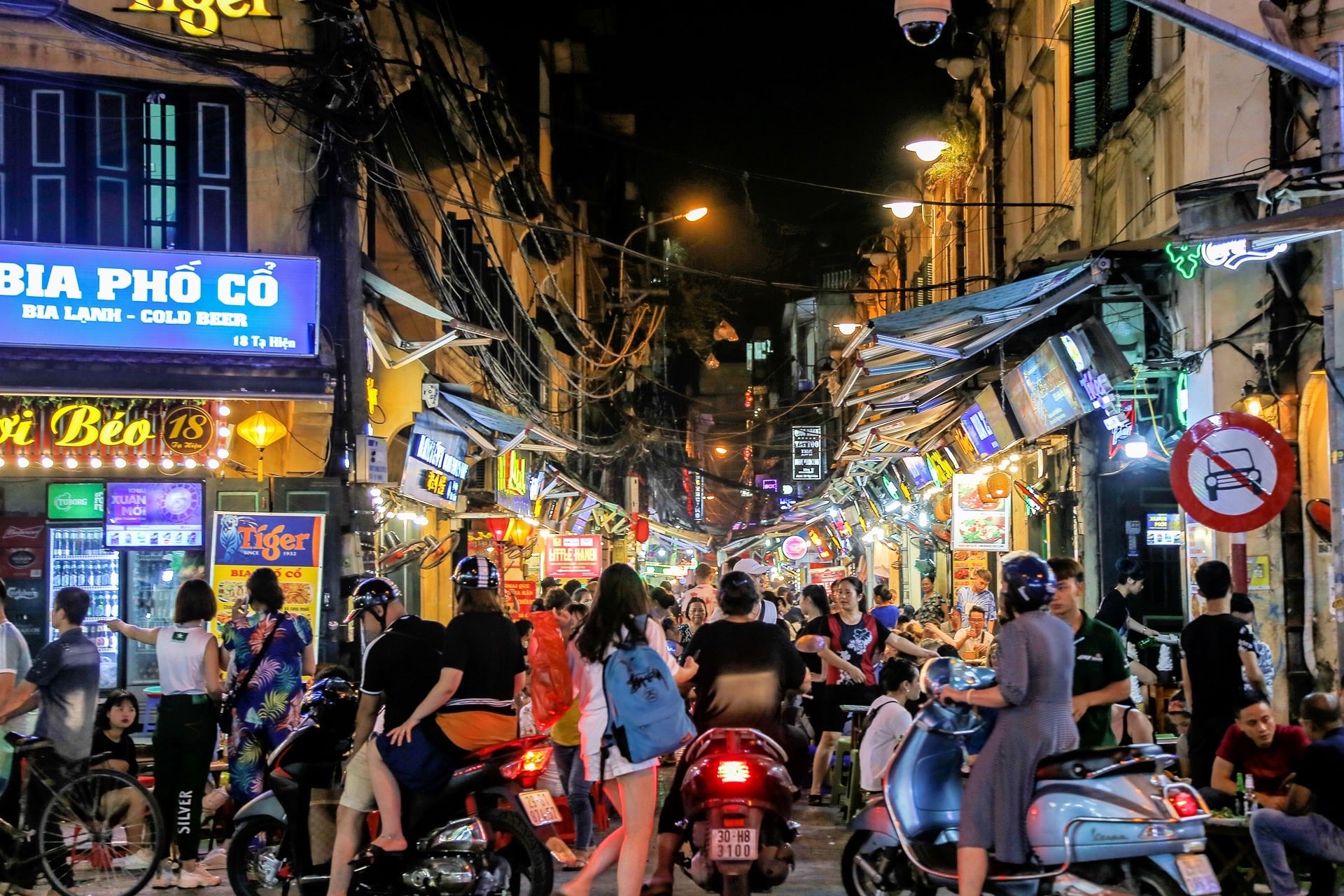

Terrifying, yet a definite bucket list, if we ever visit there. The boys are adorable once again
Wow-I felt that I was right there watching the train. Great posting!